
























eDItoR: David Beasley
AssIstA nt
eDItoR: Eleni Bide
eDItoRIAL AssIstA nt: Sophia Tobin
Copyright © 2012
The Worshipful Company of Goldsmiths
No part of this work may be reproduced, stored in a retrieval system or transmitted in any form or by any means, including copying and recording, without written permission from the copyright owner, application for which should be addressed to the Goldsmiths’ Company. Opinions expressed in Goldsmiths’ Review are not necessarily those of the Editor or the Goldsmiths’ Company. Whilst every effort has been made to verify statements of fact by contributors, no responsibility is accepted for errors or omissions by them. Prospective users of techniques, materials or equipment described should take specialist advice on official safety precautions and regulations which apply to them. Both may vary from country to country.
Correspondence
The Worshipful Company of Goldsmiths, Goldsmiths’ Hall, Foster Lane, London EC2V 6BN
Designed and produced by:
The Pulse Group Limited
Pulse House, 1a Lonsdale Square, London N1 1EN
Printed in England ISSN 0953-0355

Cover illustration: The chandelier in the Drawing Room. Photographed by Richard Valencia.
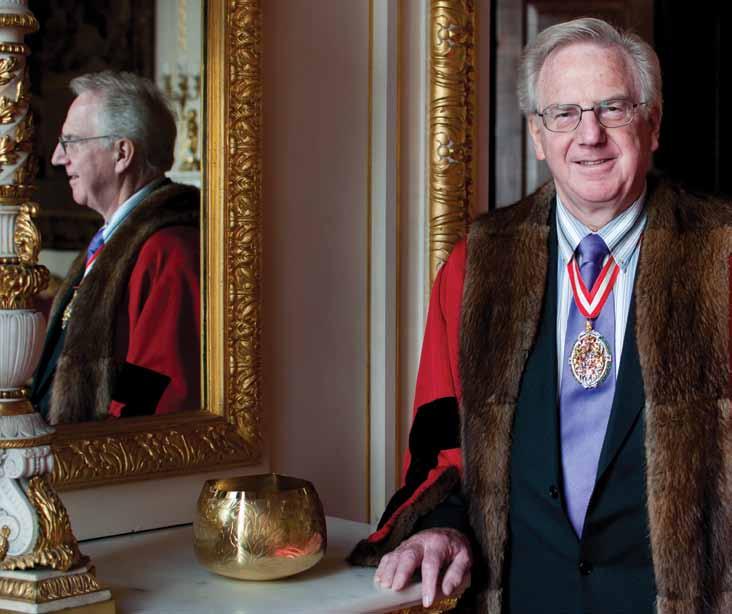
By David Beasley
A measure of the esteem in which the new Prime Warden is held can be gauged from an extract from one of the most pervasive sites of electronic data – Wikipedia – where he is described as ‘...one of the UK’s most distinguished philosophers of religion’. In conversation with Stewart Sutherland (Lord Sutherland of Houndwood) one is struck by his very engaging manner and tone of voice.
His education began in Woodside Primary School, near Aberdeen, in 1946 and he has nothing but praise for the redoubtable Miss MacDonald to whom teaching was a vocation and who sought to help her ‘children’ to find what was best for them. His fairly modest nurture was enhanced by the many books at home. In fact as a boy his greatest desire was to open the batting for England – Alec Bedser, Peter May
and Denis Compton were early heroes. He did confess to playing hookey from his secondary school, Robert Gordon’s College, in his early teens, to watch the great Australian touring side in the mid-1950s which was playing courtesy matches around the country. Rugby was another of his sports. Playing conditions on the east coast were occasionally adverse – cricket had to be called off because of snow at least once a season. He mostly enjoyed secondary school and was the first member of his family to attend university. He studied Classics (Latin and Greek), Maths, Advanced Maths, English and French for his Highers and was successful in winning a bursary. Since the age of 15 he had wanted to study Philosophy, very much encouraged by his school teacher
(of Literature and Philosophy) Ian Forrest. This inspiring teacher arranged for Stewart to meet Donald MacKinnon who held a Chair at Cambridge and was to be a major influence on his life. Obtaining a first class degree at Aberdeen he was accepted for an MA at Corpus Christi College, Cambridge, where he joined his mentor. Although hugely eccentric, MacKinnon was a genius with a great capacity for penetrating thinking.
Stewart Sutherland’s intellectual training involved Moral Philosophy and the Philosophy of Religion. The purpose of a philosopher was to hone one’s analytical abilities, in order to distinguish facts from values, and to prioritise. He described the process in layman’s terms as “pushing out past the normal boundaries, and having the capacity for abstract thought and to apply that to practical problems”. He also spoke, in a lecture at Gresham College in 2008, in the following terms: “I am a sceptic. That is my standard pose, trained in Philosophy, that was what I used to do for a living.”
Following his MA at Cambridge he gained teaching posts at University College of North Wales and the University of Stirling (1968-1977).
The latter was a new university and he gained a tremendous amount of experience there and was given major responsibility for parts of the curriculum. He learnt very much from first principles for which his philosophy background was ideal, and he acquired a taste for being in the thick of the action – making and shaping events.
He applied for the Chair of Philosophy of Religion at King’s College London, and taught there from 1977-1985. Again he was plunged into a very demanding department and he published Atheism andtherejectionofGod (1977), God, Jesus and Belief (1983) and Faith andAmbiguity (1984). His leadership qualities led to his promotion to Principal at King’s College (1985-1990) at the time of the amalgamation of three separate colleges and a medical school.
His decision to approach the Secretary of State, Kenneth Baker, directly with a top team paid dividends in the acquisition of
a large site on the north of the river on the Strand in London. He remembers to this day signing a cheque for £12m!
Chelsea College and Queen Elizabeth College were brought into the new institution and the number of sites reduced considerably. He then moved on to the Vice-Chancellorship of the University of London (1990-1994).
Although sad to leave King’s, he was persuaded that he could make a significant contribution at Senate House and again was in the thick of changes to the status of the London colleges.
Places of research and of teaching were able to go directly to funding agencies on the basis of merit, enabling, for example, Schools of Advanced Studies to obtain special grants from the University Grants Council. They are subject to quinquennial review. Although these changes were expected to take five years, all was in place well within that time. Thus having
of the Elderly (1997-1999) and a member of the Committee which reviews care for the elderly in Scotland (2007), he is very much involved in health issues. Alzheimer Scotland, of which he has been President since 2002, and the Centre for Dementia at UCL, (Patron since 2008) are just two of his many concerns. His other external interests include chairing a UK/Malaysian Company introducing IT services to all Malaysian mainland schools, and chairing The Associated Boards of the Royal Schools of Music.
Besides his many honorary degrees he was knighted in 1994 and invested with the Order of the Thistle in 2003. He joined the Goldsmiths’ Company in 1987 when he was spotted by the late Dr Gordon-Smith. He was elected to the livery in 1991 and to the Court of Assistants in 2000. His work on the Education Committee is guided by the desire to understand what it is that the Company can
The purpose of a philosopher was to hone one’s analytical abilities, in order to distinguish facts from values, and to prioritise
some ‘spare’ time he took the job of Chief Inspector of Schools and set up Ofsted,a non-ministerial government department which was intentionally outside the control of the Secretary of State for Education. In his view it has stood the test of time.
He was invited to become Principal and Vice-Chancellor of Edinburgh University (1994-2002) – an offer he could not refuse. In more recent years he took up the post of Provost of Gresham College (2002-2008) where he has delivered lectures on a variety of subjects as well as hosting many more.
Outside his academic life he has chaired numerous important government committees relating to education and he chaired a Committee on Appeal Court Procedure in 1995-6. More significantly, he is an active cross-bencher in the House of Lords to which he was elected as one of the first batch of ‘people’s peers’ in 2001. As Chairman of the Royal Commission on Long Term Care
do to help. The Science for Society courses and the primary school initiatives are examples of the Company endeavouring to make a difference and to offer encouragement to those who are doing excellent work in the field of education which is such an important aspect of our national life. His role as Prime Warden is very much in line with our current activities – with its focus on the educational and charitable aspects, the trade and the Goldsmiths’ Centre in particular. His wife, Sheena, a clinical virologist by training, ran Virology services for a large part of South London but, with the very varied roles which Lord Sutherland has fulfilled, has been generously flexible in her career. We may see more of his two daughters, Fiona and Kirsty, than his son Duncan, who is presently living in Denmark.
No doubt the Company will benefit greatly from his highly developed clarity of thought and his ability to prioritise the key issues which will be affecting the Company in his year of office.
The life of a designer and silversmith can be insular with long hours spent in the studio or at the bench, so my time as Prime Warden has involved a complete change of lifestyle. It has been an exciting year of social and ceremonial events with frequent receptions and dinners to attend. My formal duties have occupied many days with meetings, committees and official visits, whilst craft related activities have been dominated by the need to ensure that the Goldsmiths’ Centre building was finished on time and within budget. But as always the Company’s other craft support activities have marched on, with the requirement for me as a ‘trade’ Prime Warden to attend the apprentice receptions and student courses, visit workshops, open exhibitions and host private views for the Fair, to name but some of the many events that promote the Company’s support for jewellery, silversmithing and allied crafts.
By Hector Miller
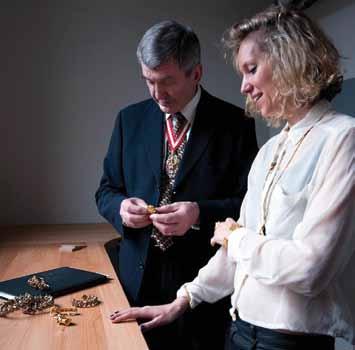
Amongst all this activity there were many highlights, but one aspect of my year that stood out was the opportunity I had to meet children and young people engaged in creative craft projects and talk to their tutors about the state of vocational training in the education system. This interest was partly a result of my involvement with the setting up of craft courses at the Goldsmiths’ Institute, but mostly because of my own concern that the teaching of practical subjects is increasingly absent from our schools, replaced, if at all, by the virtual world of computer skills. I have always believed my father, a headmaster, was right when he said that in any of his classes there was always a proportion of children who, whilst obviously needing to be taught numerical and literacy skills, were clearly going to have more fulfilled lives if allowed to use their vocational abilities. But just like academic aptitude, practical skills are much
easier learnt as a child and become a transferable facility that can be applied in many ways later on in life.
I know for instance that there is a childhood link between my father letting me help to make beehive foundation combs using molten wax, and the work I did, in the 1980s, on developing a technique for TIG welding my pieces together with molten silver.
It is no surprise then that the truly inspirational events of my year have been connected with craft training.
At primary level I visited one of the Tower Hamlets schools which the Company provides with a grant to support literacy and numeracy programmes; however it was a creative craft lesson, run by one of our Freemen, the silversmith Julie Chamberlain, that was so much fun I just had to take my jacket off and help the children with their projects for a while.
At the other end of the schools spectrum I presented the prizes on
many parts of London. I saw some of the inspiring programmes run by a dedicated team of staff, and was impressed by their engagement with groups of seriously disadvantaged young people; it made a convincing case for the Company’s continued support for inner -city deprivation.
has helped to provide support for Territorial Army soldiers’ families from Oxfordshire and beyond.
Speech Day at Stockport Grammar School, founded by the Goldsmith, Sir Edmund Shaa, in 1487. Frances and I were very impressed by the work seen on a tour of the school, particularly in the popular craft and design annexe where the sophistication of the pupils’ work was a real testament to what can be achieved. Worryingly such courses are now available at only very few schools as part of the core curriculum.
Vocational training would certainly have helped some of the teenagers that the London Youth Club Association take to its residential centre at Woodrow High House. Originally Oliver Cromwell’s estate in Buckinghamshire, it was acquired by the Goldsmiths’ Company which, soon after the Second War, gave it to London Youth as a place for running activities and events. Today this includes helping to tackle serious problems such as gang culture and violence amongst the youth from
A visit to Goldsmiths’ College to present students with Company bursaries was also a very rewarding experience. Although founded in 1891 by the Goldsmiths’ Company to provide technical and vocational skills to working class men and women in New Cross, it is today a college of the University of
I was privileged to visit their barracks in Abingdon and to learn how the Company’s contribution provides much needed social and educational opportunities for these military families, bringing them together for mutual support whilst a spouse, often also a parent, is away on active duty in Afghanistan.
One of the questions always asked of an incoming Prime Warden is “what will be the themes for your year?”
Firstly for me it was a desire to address the low esteem in which this country holds its creative industries, the work
My other intention was, where possible, to help the Goldsmiths’ Centre Trustees and Director complete the building works and start commissioning the Institute and Workshop programmes. The Company was honoured to have HRH Princess Alexandra set her royal seal on the Goldsmiths’ Centre at the Opening Ceremony in April when she unveiled a commemorative stone plaque set into the floor of the Atrium. In reality the workshops have been mostly let for some time to a representative group of craftsmen from the trade, including recent graduates who occupy the small starter studios. The first postgraduate student group
i firmly believe it to be creativity that built Great Britain, and creative young people who will regenerate what is so special about this nation
London, housing amongst other departments its worldclass art and music schools. On a separate occasion the Clerk and I were able to enjoy at first hand the professionalism of Goldsmiths’ students when the Music Department gave a wonderful performance of Puccini’s opera La Bohème Unlike some of the other ancient Livery Companies, the Goldsmiths’ Company does not have a high profile schools programme. General education is, nonetheless, a very important part of its charitable work, and, in a sense, extends to a final example of my role as the Company’s representative. For five years an affiliation with the 7th Rifles Regiment
of silversmiths and jewellers being a good example. At the February Livery Dinner my guest speaker, Sir Christopher Frayling, made the point that the Creative Industry sector of the United Kingdom economy accounts for only slightly less of GDP than the contribution made by the Financial Services sector. He went on to comment that one would hardly know it from the attention British artists, designers and craftsmen have received from successive governments. I firmly believe it to be creativity that built Great Britain, and creative young people who will regenerate what is so special about this nation - but they will need to be given the chance.
has been busy with its new assignments in the Institute, the corporate hospitality spaces are already in use, and the ‘Bench’ Cafe is open for business. As I write much more remains to be done before the Centre is fully operational, but there is a great feeling of optimism amongst everyone involved and a sense of determination by the staff team to make a success of the project. I have absolutely no doubt that this groundbreaking initiative is going to be of great importance for the profession, and a justifiable source of pride for all members of the Goldsmiths’ Company for many years to come.
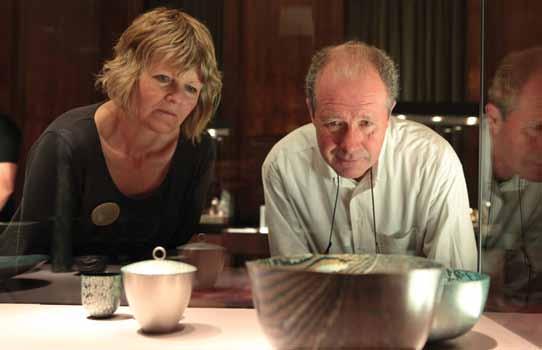
Andy Waker points out to HRH Princess Michael of Kent the Diamond Jubilee Mark on the spoon made by Steve Wager, at the launch of the commemorative hallmark on 5 July. Princess Michael was principal guest at the event which took place in the Livery Hall. It was attended by representatives of the UK’s four assay offices, which collaborated to promote the mark, which depicts HM Queen Elizabeth II wearing a crown in a diamond shaped surround.

Curator Julie Chamberlain and exhibitor Alistair McCallum examine objects in the Mindful of Silver exhibition. Putting Ryvita and squeezy bottles on show alongside the silver they inspired, Julie set out to illustrate the intellectual and practical design processes involved in the making of innovative contemporary silver. The sketchbooks, models and unusual objects collected by the silversmiths gave visitors a rare glimpse behind the scenes to reveal the varied working practice of these creative craftsmen.
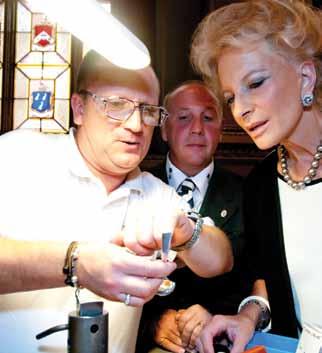
According to Bryony Jackson, winning the silversmithing prize at New Designers was “a bit of a shock”, but the awards evening was “a great experience – it gave me the opportunity to meet lots of influential people”. The prize money has helped her to set up her own workshop.
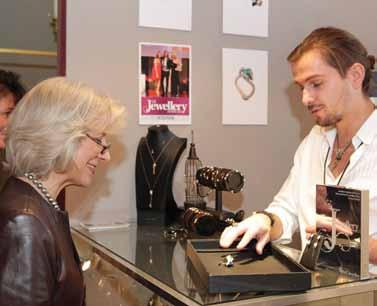
Jewellery prize winner Filipa Oliveira commented that the award was an important recognition of her talent and hard work. “It was also a big help and motivation for someone that is starting in the jewellery industry.”

The Duchess of Gloucester showed great interest in Tomasz Donocik’s ring when she visited on 27 September. The twoweek fair showcased the work of 180 craftsmen, with 10 stands being allocated free of charge to selected recent graduates. Exhibitors reported that the economic climate had prompted changes in visitor buying patterns, with silversmiths experiencing an increase in sales of smaller items, whilst jewellers found that clients gravitated towards more expensive statement pieces. The Best New Design awards in both weeks went to two recent graduates: jeweller Emmeline Hastings in Week One and silversmith Charlotte Tollyfield in Week Two.
Theresa Nguyen and the Hon. Richard Curzon present the silver beaker made during Theresa’s eight month residency to prize winner Mrs Sheila Lake. Theresa said the experience “really enabled me to feel deeply connected to the silversmiths of the eighteenth century that worked here and produced such beautiful pieces”. She found that visitors were “genuinely surprised” by the tactile nature of silver, and gave her lots of positive feedback about her live demonstrations.
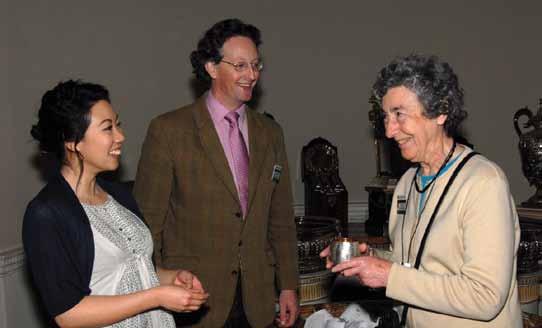
Shaun Grace had the opportunity to present his award-winning pair of flower vases to Martin Roth, the Director of the V&A, at a reception held in the museum in October. Shaun, who graduated from the University for the Creative Arts at Rochester, is now at Bishopsland, and has made two more pieces for a six month exhibition, organised by Contemporary British Silversmiths, in the V&A which opened in March 2012.
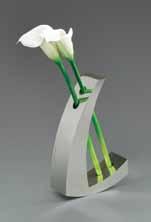

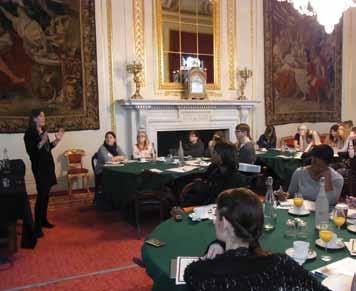
The Company’s week-long introduction to business course is now over 30 years old and has helped to launch many careers within the industry. This year well-known figures, including Liz Olver, Design Director for Annoushka Jewellery, shared their knowledge with 40 GettingStarted delegates at Goldsmiths’ Hall.
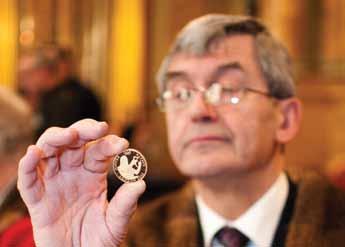
Miriam Hanid has taken up the place of artist-inresidence at Ickworth House in Suffolk with her silversmiths’ workbench, complete with tools and equipment. Miriam will be on hand herself on Saturdays until November to demonstrate her skills by making a beaker inspired by natural themes including wood carvings and a Ming vase in Ickworth’s interiors.
A fortunate visitor may be the lucky recipient of the prize draw for the beaker at the end of the season.
A short film about her residency can be seen on the websites of the Company and Ickworth House.
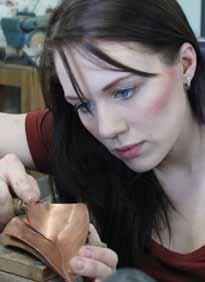
Kate Earlam was selected as the winner in January, with her innovative design for a fruit bowl a prototype of which she has made in copper. A postgraduate student at Bishopsland, Kate will make up her piece under the supervision of Clive Burr, in his new workshop in the Goldsmiths’ Centre.
trial of the p yx Seventeen Jurymen, including the Prime Warden, Hector Miller, counted nearly 82,000 coins during the Trial of the Pyx in February, including specimens minted to celebrate London’s Olympic Games. The Chancellor, George Osborne, who is also the Master of the Mint, was welcomed back to Goldsmiths’ Hall for the second year running to attend the Delivery of the Verdicts in May.
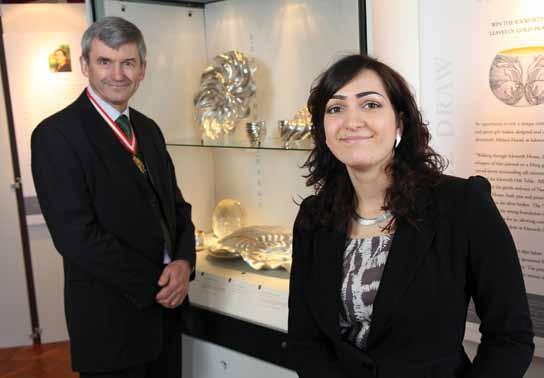
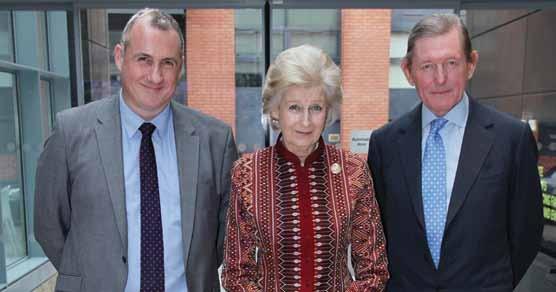
Her Royal Highness Princess Alexandra visited the workshops and the Goldsmiths’ Institute in the company of Martin Drury, the Chairman of the Trustees, and Peter Taylor, the Director of the Centre, at the official opening of the Goldsmiths’ Centre on 25 April 2012. Her keen interest was much appreciated by those attending. opening the Goldsmiths’ centre
By Rod Kelly
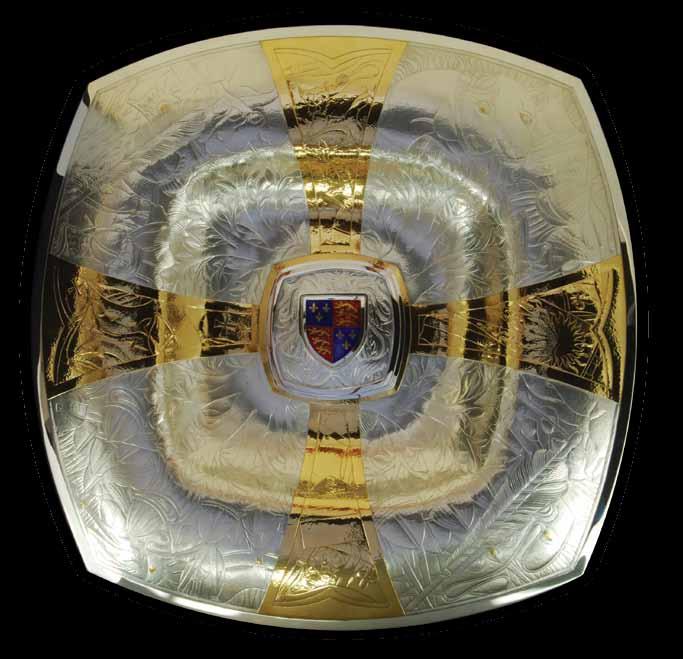
The Queen Elizabeth Scholarship Trust (QEST) was born out of an interest in the retention and expansion of the unique craft skills witnessed by the Royal Warrant Holders – individuals or firms who have supplied goods and services, for at least five years, to the Queen, the Duke of Edinburgh or the Prince of Wales and who have received Royal Warrants of Appointment. In 1990 the Royal Warrant Holders created a Trust to oversee the further development of the crafts by funding scholarships so that young makers could train with master craftsmen, the aim being to preserve some of the crafts which have been such an important part of our British heritage. The Trust was formed to mark the 90th birthday of the late Queen Elizabeth The Queen Mother and the 150th anniversary of the founding of the Association. The funds were donated by the Royal Warrant Holding
...it is the subtlety and understanding of the small detailed nuances which show the real understanding of the art of the maker
Companies which initially submitted applications for scholarships from their own craftsmen. Since 1990, QEST has supported 240 individuals involved in over 100 different crafts. In my own case I applied, in 2000, with a view to studying with two makers: Ian Calvert, a well-known silversmith who had been a time-served apprentice with R.E.Stone; and Alan Mudd (now retired), who had been trained as an engraver and then as an enameller and later formed Fred Barnes Enamelling. I trained at art school for seven years, first at Birmingham followed by three years at the Royal College of Art under Gerald Benney. After seven years I had developed good skills both in design and in silversmithing. At the Royal College I was fortunate to be taught by Jon Bartholomew as a technical tutor who had himself been a foreman silversmith with C. J. Vander. An art school education gives young makers a wonderful creative opportunity to express themselves and can be a launching pad for those who want to become designer craftsmen. However it has never tried to fulfil the role of producing wonderful craftsmen with very high technical skills. This has left a void and there have been times during a commission in my own workshop when I have felt that I have been trying to re-invent the wheel – lacking not the skill but the technical experience as to how to proceed. With Ian Calvert I made a large silver dish. The small
differences in approach were really interesting because the process challenged the way I thought about raising a piece of silver into a shape or sinking a form by hand. From annealing large pieces of silver to soldering on the wires, I had often struggled on my own. It was heartening to witness Ian also having problems using a large soldering torch with a huge amount of heat and lots of large split pins holding the wire edge in place before soldering, perfectly, a large
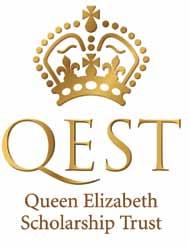
silver dish. The intense heat creates distortion. Our different approach to tackling the difficulties and to the hammer work involved was, for me, an invaluable experience. In all it built up my confidence and gave me the belief that I could overcome the challenge of making large pieces of silver by hand, on my own, in my own workshop.
With Alan Mudd the experience was very different. I had identified a need to know how to engrave deep cells or recesses in silver to inlay pieces of fine gold. Having
studied hand engraving at evening classes at Sir John Cass College (while at the Royal College) with Stanley Reece, a very fine cutter of letters and copper printing plates, I had adapted these skills myself to produce shallow carved cells into which I could inlay gold. Alan Mudd had for much of his life been carving similar cells or recesses for champlevé enamelling. The technique was transferable and, soon, Alan had me carving silver with very different tools, sharpened in a totally different way. The nuances of the technique are very subtle but very rewarding and I have now acquired the skill to complete any shape of gold inlay as part of a decorative piece of chased silver.
Working with both these masters of their crafts was a wonderfully enriching experience and I now pass on these skills when I teach at Bishopsland, where I am a Trustee, and on short courses at West Dean. In general all crafts can be taught but it is the subtlety and understanding of the small detailed nuances which show the real understanding of the art of the maker. These skills and techniques must never be lost.
Other names in the world of silver and jewellery who have received grants from QEST include Wally Gilbert, Grant McCaig, Jacqueline Cullen, Zoë Harding, Charlotte De Syllas and, most recently, Hazel Thorn. The Trustees look for well-thought-out projects,
which will contribute to the pool of talent in the UK and which reflect the excellence of British craftsmanship extolled by the Royal Warrant Holders. I am most grateful to the Royal Warrant Holders, and I would encourage any young silversmiths (and jewellers) to apply for a scholarship (www.qest.org.uk).
By Professor Caroline Barron
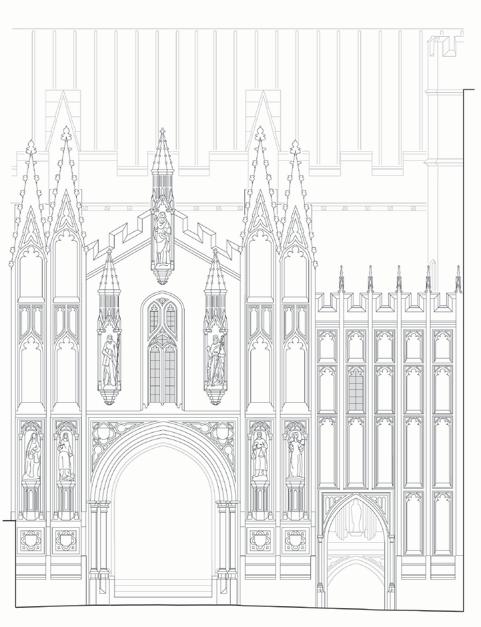
The year 2011 marked the 600th anniversary of the building of the City of London’s magnificent Guildhall. At the end of the fifteenth century, Robert Fabyan, the London alderman and city chronicler, wrote: ‘In this year [1411] also was the Guildhall of London begun to be new edified and of an olde and little cottage, made into a fair and goodly house, as it now appeareth’.
The great hall, which still serves as the City’s Guildhall, was not the first civic hall in London. The city had had some sort of Guildhall since the reign of Henry II at the end of the twelfth century. This earlier building stood on
the same site as the present Guildhall and lay within the footprint of the recently-excavated Roman amphitheatre. The building was about half the size of the present hall. Adjoining it was a chapel, which, in the early fourteenth century, was the home of the Society of the Puy founded, in imitation of the similar society at Arras, to foster music and poetry together with pious and charitable works. But by the end of the fourteenth century, the Society of the Puy had been abandoned and the Guildhall (Fabyan’s ‘olde and little cottage’) and the chapel were both in need of rebuilding to meet the requirements of the developing civic administration and the ambitions of the leading London merchants. Moreover, in 1400, Richard II’s magnificent remodelling of Westminster Hall had been completed, and the Londoners were anxious to match, if not surpass, the king’s achievement.
When taking the decision to rebuild their Guildhall, the Londoners may have sought the advice of Walter Walton, the king’s master mason, who had worked with the famous Henry Yevele on Westminster Hall. But the real architect of the Guildhall was the London mason, John Croxtone. He devised the plan to raise the great hall on a double crypt, the western crypt of the old Guildhall, and the new eastern crypt which is the fine structure which we can see today: a vaulted room of three aisles with clustered Purbeck marble columns. To strengthen the great hall above, Croxtone added exterior buttresses along the north and south walls. On the interior these buttresses formed clustered shafts which supported massive stone transverse
arches for the roof. This roof was destroyed in the Great Fire of 1666 and was replaced by Wren with a classical coved ceiling. In the nineteenth century this was thought inappropriate and the City Architect, Horace Jones, provided a ‘medieval’ hammer beam roof. This, in turn was destroyed by fire bombs on the night of 29 December 1940 and, in the post-war restoration, Giles Gilbert Scott reverted to Croxtone’s original roof
six of the original statues which occupied niches in the porch, had survived in situ into the eighteenth century
design, although he added a row of clerestory windows to improve the lighting.
Croxtone took twenty years to create this ingenious and impressive building, which has lasted for 600 years and survived two engulfing fires. In 1440 Croxtone petitioned to have the house over the back gate into Guildhall in recognition of his long service of twentynine years as mason working on the ‘Common Guildhall’. Four years later he again had to petition to be paid money he was owed and for a salary rise from £1 to £3 per annum. He died soon afterwards. His achievements have been insufficiently recognised: he also worked for the City on the new chapel next to Guildhall; on the city’s water supply piped from Tyburn; on the new Leadenhall market; and on the great Cheapside Cross. Of these works, only the Guildhall remains: a remarkable specimen of perpendicular architecture (albeit much restored) and a monument to Croxtone’s vision and technical skill.
The London Guildhall is a comparatively stately building; there are few flights of fancy – nothing to match the carved angels supporting the roof of Westminster Hall. Moreover by the time that Croxtone had added the court rooms for the mayor and aldermen, and the new chapel and the common library, the hall itself was closely hemmed in. Today, more of the exterior of Croxtone’s Guildhall can be seen than would have been visible in the fifteenth century. But the great hall did have one flamboyant aspect – an
elaborate double porch facing onto Guildhall yard. The present facade was designed by George Dance in 1788 in his famous ‘hindoo-gothic’ style – Croxtone’s porch being so decayed that its facade had to be removed. Six of the original statues, which occupied niches in the porch, had survived in situ into the eighteenth century. Four of these were sold and ended up in a stable yard in north Wales from where they were recovered in 1972. They are now in the Museum of London.
It has been possible to reconstruct the appearance of Croxtone’s original porch using eighteenth century drawings and architectural fragments. Perhaps surprisingly, the statues were not of saints. The two lost statues in the upper niches were said, in the sixteenth century, to represent Law and Learning and in the eighteenth century they were believed to be Moses and Aaron. The other four surviving statues represent the cardinal virtues, from west to east, Temperance who is diluting wine with water; Fortitude dressed in chain mail and holding a sword; Justice holding a pair of scales and Prudence grasping a snake and a mirror. Although it is not

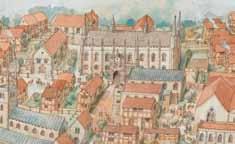
known who carved these statues, it is likely that John Carpenter, the city’s common (or town) clerk (1417-1438) and the leading lay intellectual of early fifteenth century London, provided the ideas. As an executor of Richard Whittington (d. 1423), Carpenter had used some of the money from, Whittington’s considerable estate to pave and glaze the new Guildhall and to pay for a new stone building on the east side of Guildhall yard, to serve as a ‘common library’. Carpenter owned one of the most substantial private libraries in fifteenth century London and in his will he made careful disposition of this library to his friends and fellow scholars, and the residue he left to ‘the common library at the Guildhall’. Among his many classical texts and books on the practice of government was a treatise on the four cardinal virtues attributed to Seneca. Thus it seems likely that it was the learned John Carpenter who advised the mayor and aldermen (and Croxtone) about the images to be placed on the facade of Guildhall porch, the public face of the City.
The new Guildhall, an immensely expensive project, was paid for by public/ private funding. The City for ten years doubled the fees for enrolling apprentices and purchasing the freedom, and the fines for transgressions such as selling food underweight. All this income was diverted to pay for the Guildhall. Then for the next decade the fees, no longer doubled, continued to be employed for the work on the new Guildhall. The Bridge House estates were expected to produce 100 marks (£66 13s 4d) each year. But private individuals also contributed: not only Richard Whittington, but other leading citizens specified in their wills that money was to go to ‘novo operi Guyhalde civitatis’. And so the great work seems to have been completed within twenty years, a remarkable monument to the grandiose ambitions of the City’s mayor and aldermen, the intellectual originality of the common clerk, John Carpenter and, above all to the skill, persistence and vision of the City’s master mason, John Croxtone.
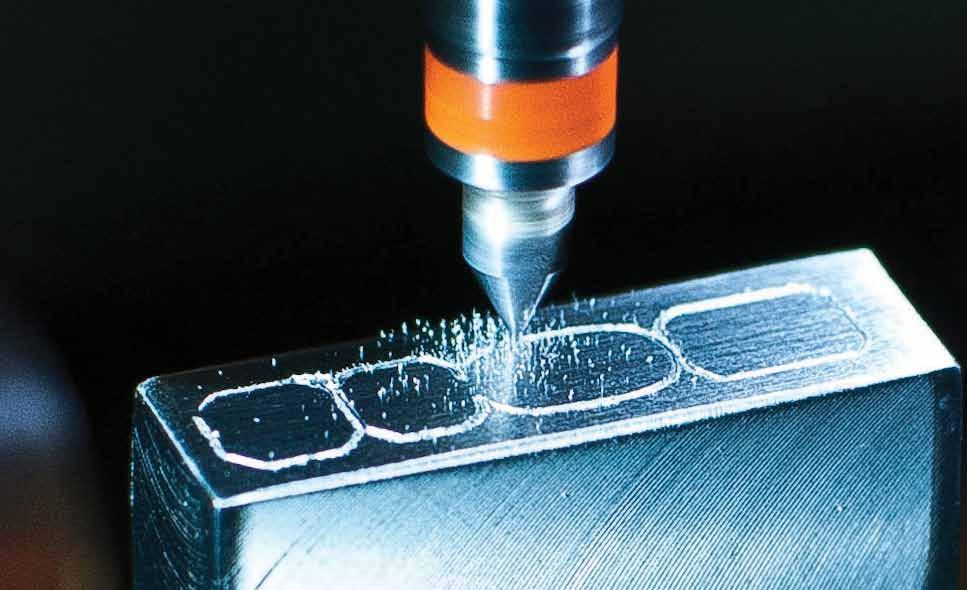
By David Beasley

In recent years the role of engineering services in the Goldsmiths’ Company Assay Office has become increasingly important as costs are squeezed and the quality of customer service is continually raised. The decline in engineering skills throughout the country has been noted in the national press but here in the City of London they are on an upward curve.
The presence in the Engineering Department of Pat Geary and his team of three – Simon Jones, Daniel Love and James Richardson – provides an essential cog in the smooth running operation of the hallmarking services. Some say that Pat
has been here since this Hall was built! He has the steady, resolute and calm air of a man who is used to fixing intractable machinery and to constructing tools and punches from unbending steel. There is no engineering problem that cannot be solved!
In reality, Pat has not been here since 1835. He started a little later, in 1978, when he was apprenticed to the Deputy Master, the late John Forbes, and worked with Frank Salmon. Taken on as the first engineering apprentice, Frank and he were responsible for all of the machinery – marking presses, support tools and balances – in the Office. All
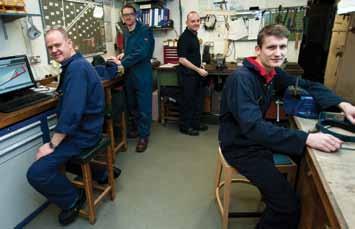
which he manipulates the hard steel to shape punches and support mounts.
marking was undertaken by press machine or by hand.
On Frank’s retirement, Dennis McGrath came in and Pat was joined by a second apprentice, Richard Love, in 1980.
Pat’s training involved dayrelease at college in Basildon where he took his City & Guilds Engineering course over a period of three years. Further skills were added with a one-year course in tool making at Dovedale College in Chelmsford. Pat came out of his time and gained his Freedom in 1983. He was in his element having a great passion for working with machinery to create tools. One can readily see the skill with
The engineers were housed for a while in glorious isolation in two Portakabins on the roof of Goldsmiths’ Hall. The very steep wooden steps and the lack of cover in inclement weather were deterrents to the less hardy. The author remembers going there just once! Two pantograph engraving machines had a cosier existence finding shelter on the second floor. At the time of the major refurbishment of the Hall in 1990, the whole team was moved to the basement area where the great kitchen had been situated and where they remain to this day.
In David Evans’ time as Deputy Warden, he recognised the potential in Pat and in the necessity for the Office to build up its level of skills in this area. In the mid 1980s, a Taylor Hobson 2D pantograph engraving machine was purchased and the engineers began to make sponsors’ marks in-house. They were trained at the Birmingham firm of Brittains Marking which made all the Assay Office punches for hallmarking such as the leopard’s head and lion
passant. A few years later, as their skill levels increased, a 3D pantograph machine was acquired from Alexander in Mitcham and, in 1989, a die-sinking machine was bought. At this stage they were making the import mark for London – the constellation Leo – in 2D. Changes of personnel and the economic pressures of the early 1990s meant
Although the imported marks had ceased to be used, they were still making sponsors’ marks.
However Brittains, which made the Office’s official marks, ceased trading in November 2004 and Pat had to travel to Birmingham to ensure that a large vanload of the Office’s master patterns were transferred safely to the punchmaker, Birmingham Marking Company, a subsidiary of the firm Frederick Follows. This arrangement was always of concern to the Office because only three of Brittains’ engravers, capable of undertaking the skilled work, moved to Follows and there was some doubt as to the long term future. An initial approach to a German firm, H W Pickardt, although
Manager, and Pat began to consider using a laser machine for manufacture of the smaller 3D punches. After a considerable amount of research and development, a state of the art engraving laser from a German firm, acsys Lasertechnik, was purchased.
Installed last autumn, and using Delcam’s ArtCam software programme for the design of the punches, the machine is now paying dividends. It is able to produce detail in the smaller punches at a superior resolution to pantograph engraving, and, with a multi-station punch holder, it is capable of working overnight, freeing up precious time in the day to finish the punches. Since January 2012, the Office has
Pat has the steady, resolute and calm air of a man who is used to fixing intractable machinery and to constructing tools and punches from unbending steel
that by 1994 Pat was the only engineer remaining. His overtime went up phenomenally and he was under great pressure.
The first laser machines for hallmarking were purchased in 1998 and Pat had to go through a whole new learning curve.
Fortunately two years later he was joined by Simon Jones, who became Pat’s first apprentice, completing his apprenticeship through the Government’s Modern Apprenticeship route. A further apprentice, Daniel Love, was indentured in 2007, and he is following the more traditional route for an apprenticeship.
promising, broke down when it became evident that it could not deliver on the quantity, and quality within the required time frame.
Pat, in his usual practical way, decided to take on the work himself and from 2009 began to cut the Office punches. He started with the sterling mark – the lion passant - and some gold marks, mostly in 2D. At this time Birmingham Marking was still making the more complicated, smaller 3D punches.
With growing confidence in the success of the in-house process, the Deputy Warden, Dr Robert Organ, Will Evans, the Systems Development
been fully self-sufficient and will provide all the Office’s official marks (560 per annum) and some 1,200 sponsors’ marks.
Pat and his team have come a long way from their perch on the roof of Goldsmiths’ Hall. Firmly ensconced within the Hall and the Assay Office their skills are now being more fully appreciated as we can see the care and attention taken in the making and finishing of these punches. Fashioned by hand from hardened steel, they are miniature works of art but are destined for a life of hard labour under the hallmarker’s hammer!
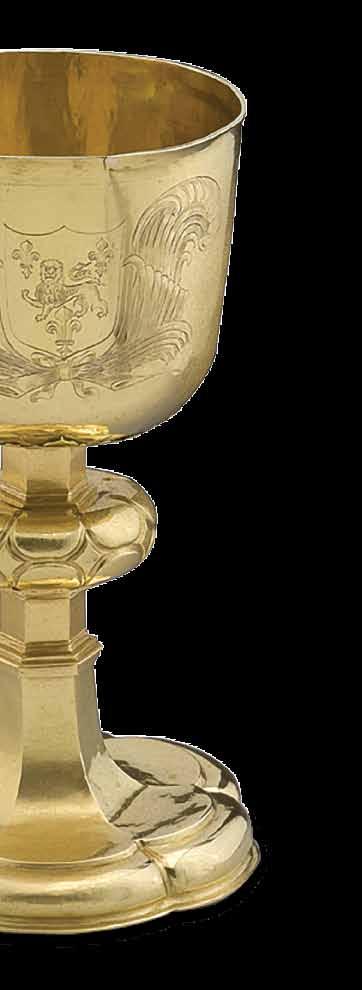
By Dr Helen Clifford

'Gold', as Roy Jastram The , (1977),
concept. Any discussion of gold requires delineation to keep it manageable’. The invitation to curate an exhibition on Gold for the Goldsmiths’ Company provided an exciting challenge in this respect.
By focussing attention on the story of Britain and gold, I wanted to highlight Britain’s position as a trading nation, a centre of invention, an ambitious empire, and a hub for scholarship and knowledge. Central to these achievements are individuals, and in this article I am going to explore some of them in more detail, something that was not possible in either the exhibition or the accompanying book. What unites these very diverse characters (from a seventeenth century Welsh East India Company servant to a nineteenth century Glaswegian chemist) is their relative anonymity and their global links. Their cumulative stories reveal a network of influence which links Britain with the world
centring on the story of gold. This article brings together the research of many scholars, whom I warmly acknowledge for their assistance. It reveals the importance of exhibitions as a means of connecting diverse strands of information to tell powerful new stories to a wider public.
I begin with the story of Thomas Davies and the handsome gold communion cup presented in 1662 to the church in Welshpool, Powys mid-Wales. It links a local family with the early days of Empire building via the East India Company. The cup bears the arms of the Davies family, and an inscription in Latin indicating that the cup was made from ‘the purest Guinea gold’, from the Guinea Coast of West Africa. Weighing nearly a kilogram, the weight of gold alone would have cost £150. It was a sincere tribute of thanks for the survival of its donor, Thomas Davies (d.1668) who had served in the East India Company as its Agent for West Africa. He had been in charge
of its trading forts and assets between 1662-3 overseeing their transfer to the Company of Royal Adventurers into Africa, which took over the trade in that year, expressly to explore and exploit the gold the Company had discovered. The gold cup is tangible evidence of the importance of the Welsh, frequently unheralded, in these early days of global expansion.
The guinea coin was minted for the first time in 1663, acknowledging its source both in its name and design, which included the insignia of the Africa Company, an elephant and howdah, often called a castle, (and the origin of ‘The Elephant and Castle’ as the name of many British public houses). The guinea continued to be minted for another 150 years, and survived long after as the unit of money, twentyone shillings, used in the sale of horses, paintings and antiques. Collectors of minerals such as Lady Henrietta Antonia Herbert,
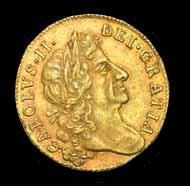
Countess of Powis (17581830) and Philip Rashleigh (1719 -1811) are further examples of little known persons outside their specific fields. Lady Henrietta is best known, if at all, as the wife of Edward, the eldest son of ‘Clive of India’. Yet, from her home in Powis Castle, she accumulated a pioneering collection of minerals including spectacular specimens of gold, via her own network of suppliers, exchanging and receiving them from around the world. Her many gold samples come from places as diverse as Brazil, Russia and Hungary. It was unheard of for a woman, let alone a lady, to collect minerals at a time when such activities were dominated by men. This exquisite collection of minerals (which totalled over 1000 specimens from South Africa to Sri Lanka) has only recently been recognised, due to the recent rediscovery of Lady Henrietta’s original handwritten catalogues, dated 1817, that had lain unidentified in a safe Her journals, kept while accompanying her husband to India when Governor of Madras (1798-1803), reveal a feisty, independent and spirited lady.
Lady Henrietta was a contemporary of Philip Rashleigh (1719-1811)
another forgotten but important mineral collector, whose acquisitions form the basis for the collection at the Royal Cornwall Museum in Truro. Born in Aldermanbury, London, he spent much of his life at the family home at Menabilly, near Fowey in Cornwall (the inspiration for Daphne du Maurier’s Manderley).
His collection includes the
Their cumulative stories reveal a network of influence which links Britain with the world centring on the story of gold
largest nugget of gold ever found in England, from the Carn Valley stream. Found in 1808 it weighs 1oz 18 dwt 6gr (see page 18). Very few of these early mineral collections survive, and they are testaments to the global networks of exchange that existed at a time when an interest in metallurgy was central to the expansion of industry. At the time Rashleigh was collecting, the industrial ‘spy’ R.R. Angerstein was reporting
back to Sweden on British industry. In Cornwall in 1753 he noted that between St Austell and Lostwithiel, ‘grains of gold are found in tin-streaming works ... and ... the local miners who live in the neighbourhood become quite wealthy within a few years, because they pick out the largest grains during the washing of the [tin] ore and sell them onto smelting houses, which in their turn sell to the goldsmiths in London’.
Some ‘collectors’ had other aims in their seeking after gold. Robert Nelson Gilchrist was born near Helmsdale in the Highlands of Scotland. Apprenticed as a cooper, he left for Australia in 1849 attracted by the tales of the gold rushes. Inspired by the similarity of the geology of his native Helmsdale with the gold bearing rocks of Australia and New Zealand,
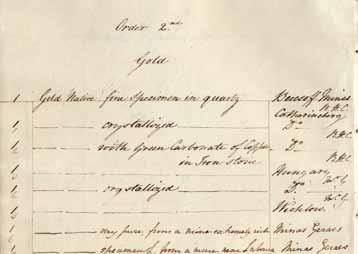
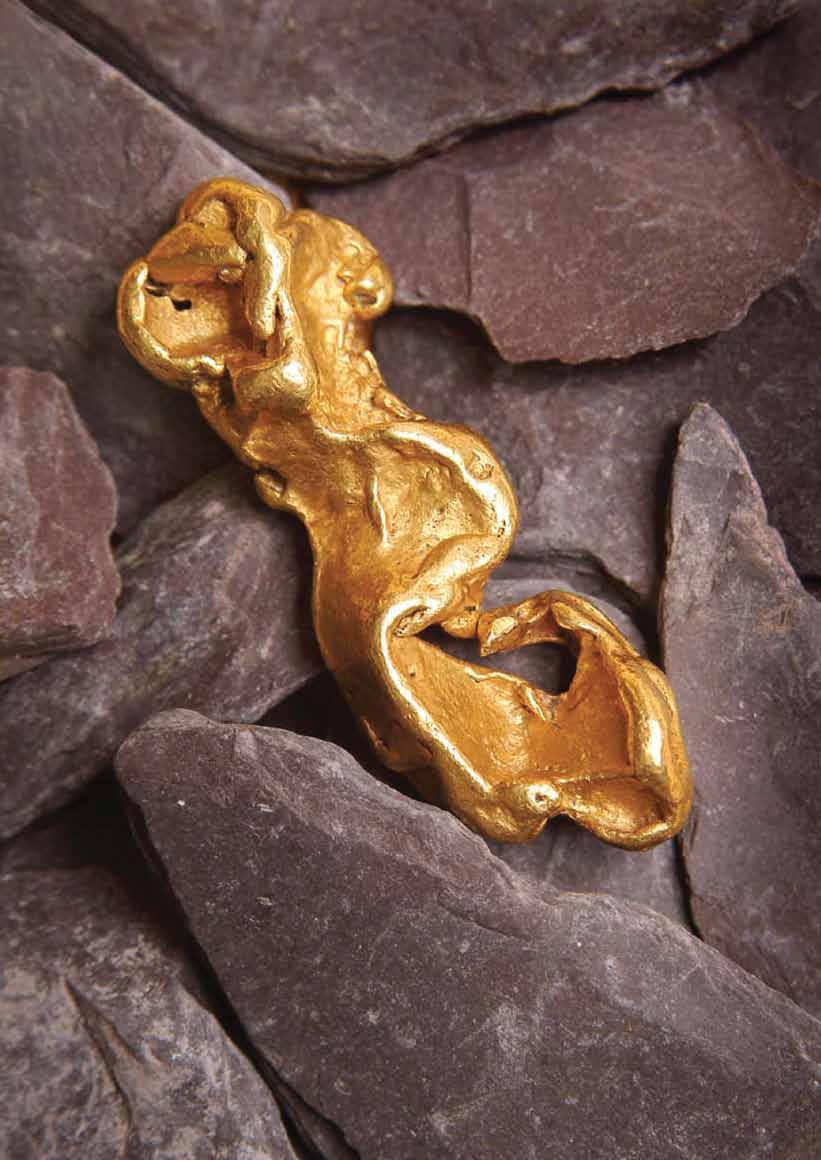
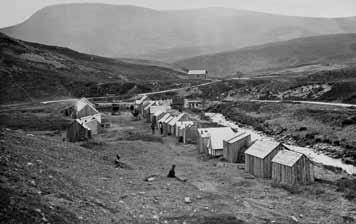
he returned home in the late 1860s to investigate. Reports of his finds in 1868 led to the now long forgotten Kildonan Gold Rush of 1869.
In March 1869 the Glasgow Herald reported that ‘There is now quite a camp on the Kildonan which is at present in a state of agitation owing to the daily expected arrival of 200 gold seekers’, many of whom had experience of gold prospecting in the colonies. The extensive camp at the Strath of Kildonan was captured for posterity by Alexander Johnston (1839-96) who had set up his photographic business in Wick in 1863. A report in the Northern Ensign of 24 June 1869 stated that he had ‘made several beautiful pictures of the gold fields and the villagers. They are exceedingly pretty and lifelike ... Mr Johnston can furnish the picture for a drawing-room, an album, or a stereoscope’. The prospecting came to an end in December stated when the landowner, the 3rd Duke of Sutherland, received complaints from his tenant farmers and fishermen about the disruption caused by the panning and spoil, and terminated the licences he had been issuing at £1 each. All that is left are a few pieces of jewellery such as this cross made from Kildonan gold
and Johnston’s photographs which can been seen at the Wick Heritage Society, in Caithness.
Without pioneers in science, in particular chemistry, these gold finds would not have been so successful. John Stewart MacArthur (1856-1920) was born in Hutchestown, Glasgow and left school at the age of 14 to become an apprentice chemist. He is the long forgotten pioneer of the first commercially viable process for refining gold by the use of potassium cyanide, a timely discovery that helped to rescue the world’s gold industry. By the 1880s it was in a precarious state, vast tailings containing at least one ounce of gold per ton were accumulating, with no practical method of recovering more than 45-55% of its wealth.
in a glory-hole under the consulting rooms of the two Forrests’.
After the ‘disappearance’ of the roguish Cassel, MacArthur was invited to join the Cassel Gold Extracting Company as Technical Manager to pursue Cassel’s electrolytic extraction process. He continued to experiment with the Forrests on a chemical method, on the understanding that Cassel Company would have first claim in any discovery.
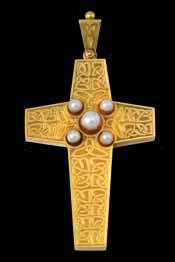
In 1886 the syndicate discovered potassium cyanide as a solvent. The MacArthur-Forrest process, which involved dissolving crushed ore in a weak cyanide solution and then precipitating the gold with zinc shavings, was patented in October 1887 and July 1888, the South African patent following twelve months later.
effects: instead of being able to refine only around 45% of metal from complex ores, as before,
be achieved.
Tragically for MacArthur and the Cassel Company, their patents were successfully challenged in 1896 and they lost any material benefits from their inventions and investment.
MacArthur’s interest in photographic chemistry brought him into contact with two doctors, F.W. and W. Forrest, who were joined by a businessman, Henry Rennel Cassel, who funded their experiments. MacArthur was later to describe this ‘quartet of enthusiasts carrying out research in the evenings
The first gold production by the new process took place in Australia and New Zealand, but it was on the South African Witwatersrand that the MacArthur-Forrest patents had their most powerful impact. Here the ores proved particularly amenable to cyanide treatment and within two years of its introduction the total weight of gold produced had risen from 40,000 to 100,000 ounces per month.
Stagnation in the gold-mining industry was arrested; the new process had striking
Despite MacArthur’s name sinking into obscurity, his genius and hard work was recognised by the Institute of Mining and Metallurgy who awarded him its first gold medal in recognition of his contribution to the profession. It is through the connection with gold that all these diverse characters are united. Each played their role in the story of Britain and gold, and each deserves better recognition. Discovering and publicising such long-lost stories is one of the crucial benefits of exhibition making, which leaves its own legacy for the better understanding and appreciation of our history.
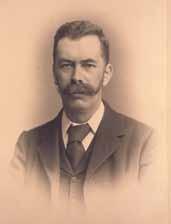

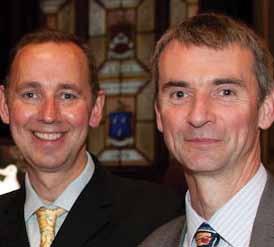
Over the past two decades, silversmithing duo Carl Padgham and Andrew Putland have quietly been creating extraordinary pieces of silver, ranging from intricate models of well-known buildings around the world, yachts and ceremonial silver, to installing the monumental centrepiece in the newest boutique hotel in London’s Knightsbridge, all from their workshop in the Kentish countryside. Their partnership has included the creation of one of the largest collections of silversmithing at any one time for the late Pope John Paul II. But it is their relationship with Bulgari, the luxury Italian jewellery and accessories brand, that has led to one of the most enduring working relationships in the industry and one which continues in its strength and stature.
a delicately chased finial echoing the carved roof bosses of the Cathedral and the base formed to reflect the central columnar structure. Around this time, they were also asked to replace a pair of stolen Omar Ramsden candlesticks. Before the days of digital scanning and prototyping, Padgham and Putland had to work purely from archival material. With the help of the Goldsmiths’ Company, which located the original casting patterns, they were able faithfully to reproduce the candlesticks. By now, they were beginning to be noticed for their outstanding craftsmanship and also as designers. This led to their involvement in an exciting and unusual project, the creation of a silver conference table, twenty metres long and two metres wide. This was a commission for a Middle Eastern government department, undertaken by C J Vander, and the pair had the opportunity of working once again with their former Medway tutor Norman Bassant. During this period, they were also commissioned to produce a pair of loving cups by the Worshipful Company of Butchers to commemorate Her Majesty the Queen Mother’s 90th birthday.
Dio Padre Misericordioso, designed by Richard Meier. Bulgari commissioned Carl Padgham and Andrew Putland to design and make 40 pieces of plate in Britannia silver for this new church, to be presented to the Vatican. The designs for the resulting collection integrated octagonal elements from their original Olympia range of silver. Weighing more than 46 kilos, the commission took two years and was heralded as a remarkable achievement when it was completed. Carl and Andrew had the honour of presenting the collection to Pope John Paul II personally in December 2000 in the Vatican, when it was formally consecrated. Among the many examples from this incredible collection of pieces were a dramatic stylised cross, out-sized altar candlesticks, an incense burner, chalice and paten, lectern, an aspergillum or holy water sprinkler and a pair of freestanding candlesticks.
Andrew Putland commented that it was “a great honour to be chosen by Bulgari to design silver for such a prestigious project; witnessing the silver being blessed by the Pope was certainly one of the high points of our careers and it is wonderful to know that the silver we created will be used in worship for generations to come.”
By Karin Paynter
Carl and Andrew met in 1984 when they were both students at Medway College of Design, now UCA Rochester, during a four-year silversmithing course under the tutelage of silversmiths Bob May, Norman Bassant and Ian Calvert. It seemed to them a natural progression when their course ended to develop a business together. On forming their partnership, they began by taking on outwork from the established silversmithing trade. As the mainstay of their work was producing silverware for the Middle East and private commissions via the Goldsmiths’ Company, this gave them first class experience in silversmithing techniques.
During the 1990s there was an abundance of trade silversmithing work. By then, with a team of four, they were working on some high profile commissions, most notably, the Lichfield Cathedral Collection. One of these pieces was an elegant flagon, the lid topped with
The longstanding relationship with Bulgari was formed when Nicola Bulgari, the Vice Chairman, visited the late Susan Hare at the Goldsmiths’ Company in 1986. Nicola was shown an award winning tea set and tray that Andrew had designed while still at college. He travelled down to their workshop the following day and promptly commissioned the pair to create bespoke silverware for the company, starting off with a rose bowl. Later, the partnership created the Olympia range of silverware, which was sold internationally in its stores, from Rome to New York. They continued to make domestic silver for Bulgari throughout the 1990s and have had a constant stream of commissions which continues right up to the present day.
In 2000, the late Pope John Paul II instigated the 50 churches for 2000 project, a huge endeavour that would see 50 new churches built in Rome for the Millennium. One of these was the
Furthermore, just before the church opened two years later, the Vatican commissioned the pair to design and make a special reliquary box. Containing the ashes of several important saints, the box was subsequently consecrated and buried in the altar behind a keystone, permanently cemented in place.
In May this year, the first exclusive Bulgari Hotel in the centre of London’s Knightsbridge opened its doors. Within the ballroom of the hotel hangs a full size pair of chandeliers, weighing 250kg
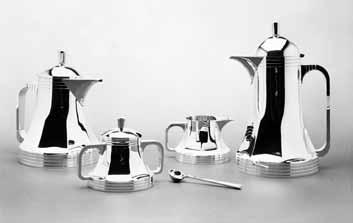
each, designed and made by Padgham and Putland. Three silversmithing companies competed for the commission but Padgham and Putland were the silversmiths eventually chosen. A huge undertaking, full size prototypes of the chandeliers in plastic and card were created in order to understand fully how they would work and look in practice. These were subsequently hung from two enormous scaffold towers so they could be shown to the Bulgari development team.
Due to the number of lights to be incorporated into the chandeliers, Padgham and Putland worked very closely with lighting engineers to ensure that they created the right atmosphere and that the wiring would be correct. In the end, it was decided that LED lights would cast a softer, more delicate light than standard light bulbs, an illumination in keeping with its intended location, the ballroom. The chandeliers were made with sterling silver and stainless steel, and constructed using CNC tube bending and TIG welding. Due to the size of the chandeliers, Padgham and Putland had, at one point, the whole of the 0.8mm sterling silver sheet available in the UK on order. The silver elements were hallmarked at the London Assay Office and were struck with the Queen’s Diamond Jubilee commemorative mark with the Bulgari logo below the hallmark, and one of the two chandeliers has been marked with Sotirio Bulgari initials, SB, as a tribute to the origins of Bulgari as silversmiths.
Carl Padgham designed four variations of the dance chandelier prototypes, naming them respectively, The Dance, The Mirror, The Parenthesis and The Swirl. The Mirror design was Bulgari’s final choice and the completed pieces incorporate a total of 260 LED lights on each chandelier and are testament to the expertise of Padgham and Putland and the team of skilled craftsmen they employed to bring the project to life. Their workshop is set in the centre of Pluckley, a small rural town famous for the television adaptation of The Darling Buds of May. It houses all the usual tools
and equipment one would expect to find in a traditional workshop, augmented by the latest additions in technology: a PUK machine and a TIG welder. There is a large vintage drawing board where all of the company’s designs and working drawings are created. Whilst Carl is responsible for most of the designing and prototyping, Andrew concentrates on organising the special commissions and overseeing the manufacturing process. It is interesting to note that both still participate in hands-on manufacturing.
At present, the pair continue to specialise in creating bespoke commissions for Bulgari for its shops all over the globe. Among these is the Alfa Nero, a model of an 82-metre luxury yacht produced in 2008. Other models include aircraft and architectural models such as the Pantheon in Rome and the Chrysler Building in New York. They are
Company apprentices: Kevin Hart was apprenticed to Andy in 1991, completed his five-year silversmithing apprenticeship and has just taken over the technician role at their former college; and Bret Symonds, who completed his five-year apprenticeship in 2002.
It is a remarkable achievement that this modest duo, who started out as working silversmiths, are now renowned internationally as silverware designers and manufacturers whose work is sold around the world.
Padgham and Putland had, at one point, the whole of the 0.8mm sterling silver sheet available in the UK on order
also developing their own collections, having recently exhibited at Goldsmiths’ Fair and British Silver Week. The pair have won many awards for their work, including a gold award from the Goldsmiths’ Craft and Design Council for a Ceremonial Mace, designed and made for Imperial College, which weighed 11kg and was made in sterling silver. They are both very proud to be Freemen of the Goldsmiths’ Company and are active within the industry, sharing and passing on their knowledge whenever they can. Andrew has taught silversmithing at UCA Rochester on a part-time sessional basis for the last 18 years. During their partnership they have trained two Goldsmiths’
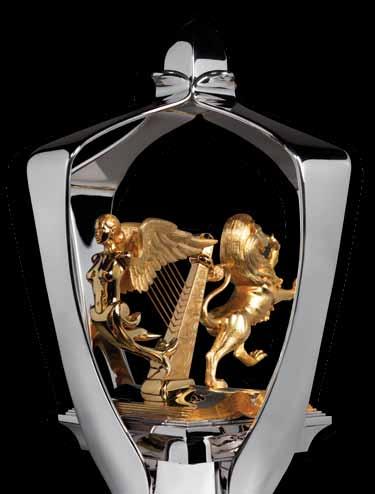

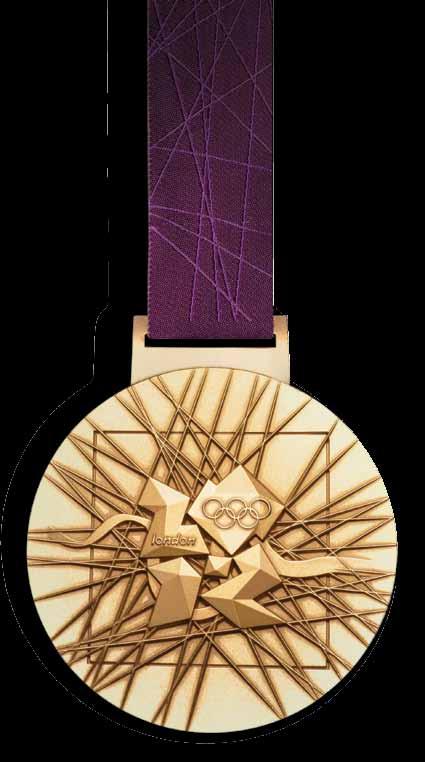
By David Beasley
The circumstances surrounding commissions for special work have a strange symmetry on occasions.
Speaking to David Watkins, jeweller and former Head of Metalwork at the Royal College of Art, this year is a momentous one for him – according to his family.
As an early advocate of a joint project between the College and the Royal Mint, his students participated in a medal competition. The very narrow confines – in terms of space and depth – of a medal provide a great challenge to students to dispense with all unnecessary detail in order to leave only the essentials of their design.
David, out of the blue, was invited last year to submit designs for the London 2012 Olympic medals to be presented at the Games.
Having rarely undertaken this type of design himself he was rather intrigued to be asked and, at the urging of his family, went to work. The upshot of this was that his initial idea made the shortlist. Further discussions, with and without David, took place involving the Victory Ceremonies Senior Producer and the Keeper of Coins and Medals at the British Museum. An independent panel, which had been set up, also provided notes and, after some design development, he was told that his design work had ‘won’ –much to his family’s delight!
I spoke to David one March morning to find out how one approaches such a prestigious commission. He emphasised that the main focus of the design was the reverse. The obverse has the goddess Nike and although
he has had some input on reworking this version, he was mostly concerned with the reverse. The brief was to use the logo - a strongly stylised form of the date ‘2012’ - and to incorporate aspects of London in some way. The medal would also be struck rather than cast and this meant limitations on the depth and the fact that any finishes or textures would have to be achieved through the die.
David used a computer programme to model the design in 3D. He decided on a central representation of the logo and, thinking of representing London, he had innumerable choices. But the heartbeat of London is its river and by the simple addition of the route of the river behind the logo he was able to soften the general geometry. The ‘river’ also could be interpreted as a ‘ribbon’ or ‘piece of silk’ – not unlike, perhaps, the old tape which used to be broken at the end of the race. Banners, flags, pennants, medal ribbons, all these connections could be evoked
it would not have had if the numbers had just sat in the middle. He also had the idea of the medal being dished –to give a sense of topology – with the 2012 logo rising from it. In fact this was not possible to the extent initially planned but the lines, or rays, are rounded and full height at the centre and taper off as they extend to the outer circumference of the medal.
Finally the incised square acts as a foil to the circular form and by its rigid shape pulls together the logo and provides a tighter focus or frame for it, thereby enhancing its importance.
In the trial production stage, which was carried out by the Royal Mint, David’s computer file was re-interpreted with the accidental effect that the dished and rounded elements of the design had acquired facetted surfaces – the result of a machine interpretation of his 3D file. In his final design, David incorporated a form of this phenomenon - an addition which creates reflection when moved and, therefore,
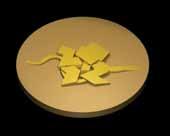

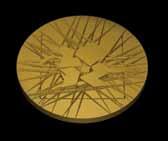
David, out of the blue, was invited last year to submit designs for the London 2012 olympic medals to be presented at the Games
in this one simple motif. Sometimes design works in a mysterious way when a ‘eureka’ moment occurs.
In order to introduce a dynamic within the circular form of the medal, he extended lines or rays following the development lines of the blocked 2012 logo. This gave a focus and energy to the medal which
the sort of ‘glitter’ one might expect from a metal which is a reward for achievement.
David is immensely gratified to know that his designs will be worn around the necks of the finest athletes, who will have shown world-class grit and determination to win one of them.
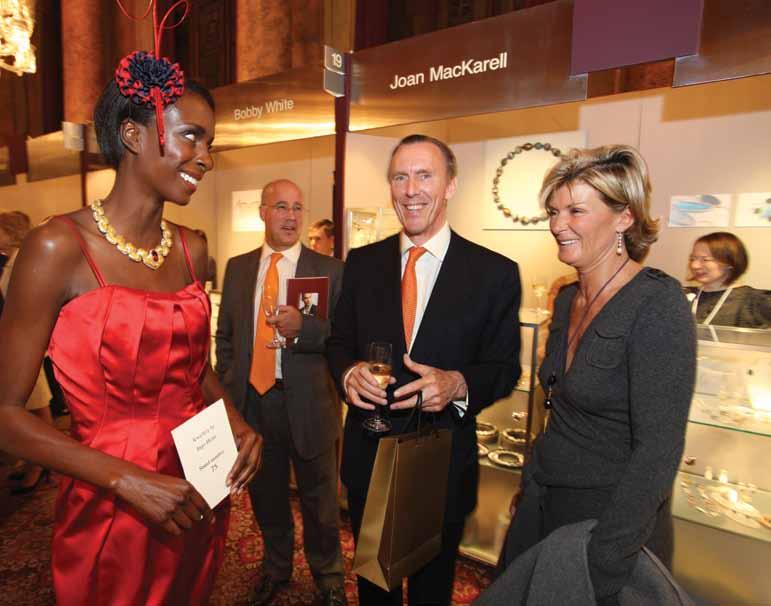
By David Beasley
It is hard to imagine a time without the Goldsmiths’ Fair such has been its impact on the collective psyche of all involved. And yet there was such a time late in the 1970s when the Loot exhibitions, established by Graham Hughes, epitomised the Company’s approach to the artist craftsman. In many
respects Loot, with its large collection of exhibits from many silversmiths and jewellers, offered a retail window to those artists whose work was outside the mainstream of the retail trade. Occasionally the ideas were better than the execution of them but it was always a vibrant and eclectic show.
The Goldsmiths’ Fair embraced the concept of Loot but took it in a different direction under the guidance of the late Peter Gainsbury. Initially intended to present an alternative and smaller group of craftsmen to the retail trade, it gradually eschewed that aspect and began to move unashamedly towards the general public as its target audience, albeit those who had an appetite for unusual jewellery and silverware. Clive Burr, the Chair of Contemporary British Silversmiths, has viewed the Fair from his perspective as a silversmith who sells to the West End retail trade: ‘This was quite a new concept when the fair first started. In general the collections of work shown and available for sale are one-off pieces or small production runs – not quite the commercial ranges which high street stores tend to stock. It gives the public a true insight into what is happening in the industry at the moment. Over the years it has been quite interesting to note how retailers have paid increasing attention to the Fair’.
Today, as it looks forward to celebrating its 30th year in September, the Fair, for Terry Hunt, the Chair of the Association for Contemporary Jewellery, is ‘an important, must-see collection of all the top names in jewellery and silver, and an opportunity to see their recent developments.’
In the third quarter of the 20th century the art of enamelling was suffering and was practised by few people working with precious metals. The Goldsmiths’ Fair, according to Melissa Rigby, the recent Chair of the British Society of Enamellers, ‘is pivotal in bringing together the work of most of our pre-eminent enamellers and showing a good variety of techniques and styles. It sets the benchmark for aspiring students who work with precious metals and presents the best selection for buyers and collectors of contemporary precious jewellery and silverware made in the UK’. The rise in popularity of enamel work must surely be in part attributable to the shop window given to enamellers by exhibitions such as the Fair and, in particular the opportunity it affords the public to understand and appreciate the level of skill involved.
In trying to assess the impact of the Fair one must remember that the venue itself, the magnificent 19th century Hall, is both inspiring and not a little intimidating. For older hands their clients find it easy to open both their minds and chequebooks in the gilt splendour of the Livery Hall or the Drawing Room, reassured by the knowledge that the reputation of the Company is invested in these exhibitors. On the other hand
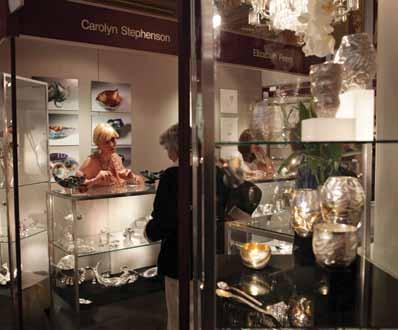
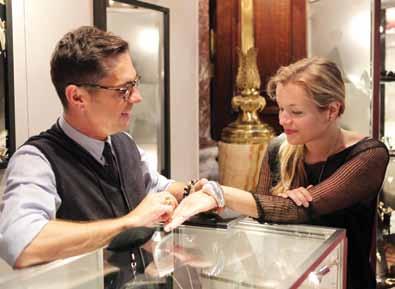
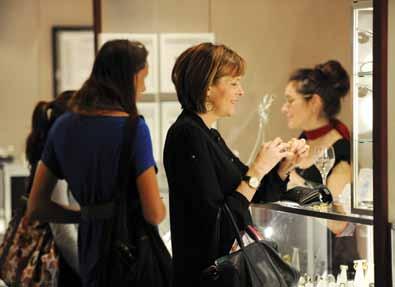
the younger ones are often in awe of their physical surroundings, and also of their fellow exhibitors, some of whom have been their idols and role models since their student days.
the scheme to offer bursaries, in the form of free stands, to graduates has helped to invigorate the Fair
One of the most affecting aspects of this particular Fair is the generosity of spirit
and camaraderie shown by the more experienced exhibitors in helping newer and younger craftsmen to settle in and to keep up their spirits when sales are flagging or non-existent. There is a tremendous network of support which extends beyond the duration of the Fair and sometimes lasts a lifetime – well, 30 years and counting! Martyn Pugh understood this when he wrote that ‘the informal sharing of experience
between exhibitors young and not so [young]…is of incalculable value.’ He should know as he has been at the Fair from the very start and has not missed a single one.
For some the Fair represents an entirely new challenge – particularly for recent graduates. To retain the freshness and vitality of an annual exhibition new blood is required. The scheme to offer bursaries, in the form of free stands, to graduates has helped to invigorate the
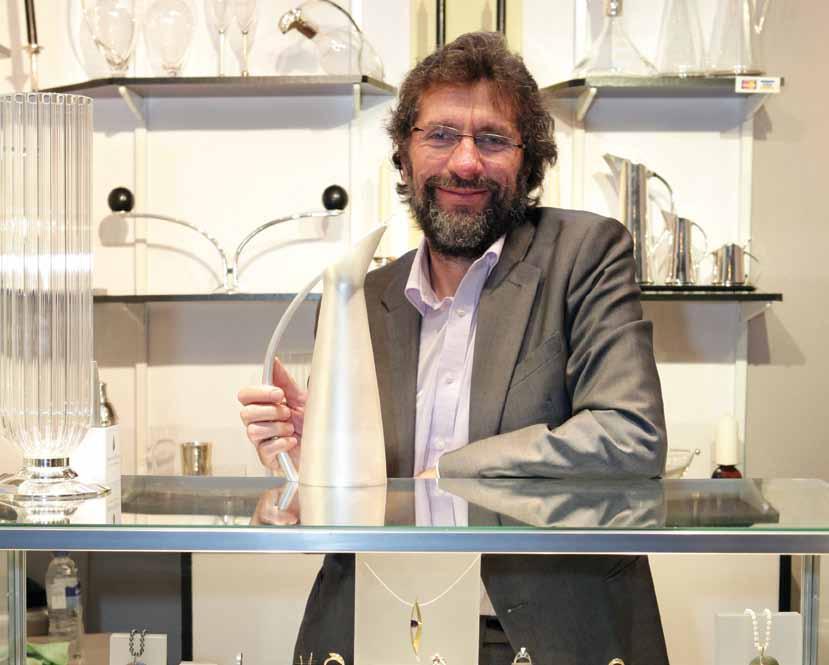
Fair and has enabled younger people to put their feet on the first rung of the ladder as professional craftsmen. The experience of exposing their work to a knowledgeable clientele and to the scrutiny of their fellow exhibitors is a daunting one. However every year there are many more applications for the stands than can be filled from the ten places available. This process is also an exciting one for the Goldsmiths’ team, led by Paul Dyson. It sees at first hand the way in which the younger exhibitors begin gradually to find their feet and grow in confidence. By the end of the week they are exhausted but also exhilarated by the experience. However it is not only those who exhibit who are beneficiaries. Martyn Pugh pointed out, in his recent speech at a party in March to celebrate the Fair’s 30th anniversary, another important factor which can be lost in the flurry of statistics regarding the footfall and the overall ‘spend’. By supporting these makers at the Fair, the Goldsmiths’ Company has indirectly helped many ancillary traders – setters, mounters, polishers, spinners, casters – whose skills the public is able to admire in the work presented on the stands. Being a man interested in figures (his costings seminar at ‘Getting Started’ is one of the most highly rated parts of the
timetable), Martyn reckoned that over the last 30 years some 640 individual exhibitors had sold contemporary work to 250,000 visitors to the value of £100m. That is quite some achievement and it is important to note, at the same time, that the Goldsmiths’ Company does not take any commission on these sales.
As each Fair passes the Goldsmiths’ team is soon at work again, improving the display cases, the lighting, the signage and the catalogue itself. A tremendous effort is made behind the scenes to arrange the numerous evening events which bring in new customers. The Fair has achieved an international reputation and attracts visitors from the United States and Australia. It has no equal worldwide as a showcase for contemporary precious metalwork.
It would be invidious to highlight individual craftsmen in such an article, but Jane Sarginson, who has only missed three Fairs, might be entitled to offer a personal view. ‘If, during my first Fair in 1982, I could see the three decades of the Fair roll out before me, how surprised and delighted I would be that the exhibition is as alive and as full of creative energy as it was in that first September. In an era of huge change, my jewellery has also evolved, both in my design and in the developments in gems and pearls… incorporating the exciting
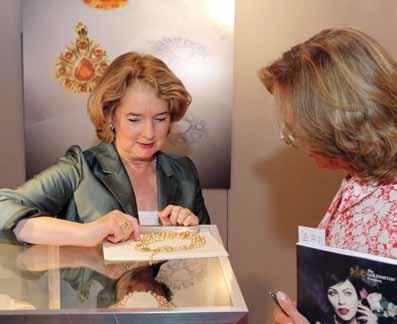
manufacturing techniques that have become available… the Fair for me has exhibited the permanence of the jeweller’s art, a heritage that I became aware of when entering the Hall for the first time.’
That permanence is represented by the standard of design and craftsmanship which is a requisite for all exhibitors and by the Fair’s continuing presence in the Hall.
craftsma NshiP, creati V it Y a Nd commuNit Y
By Peter Taylor
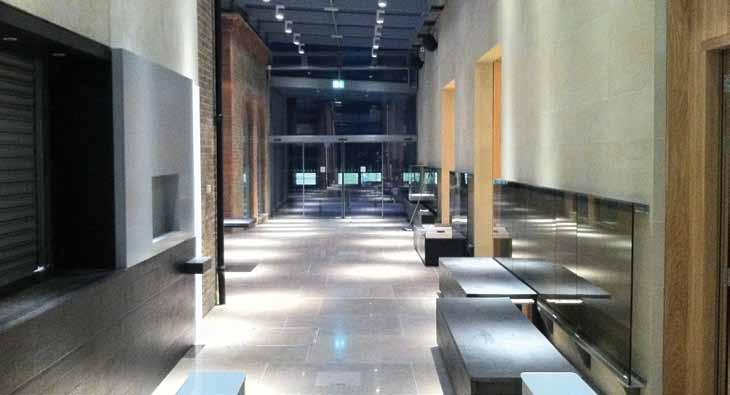
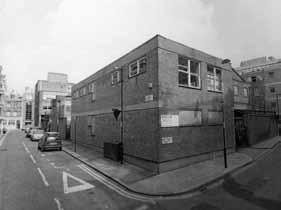
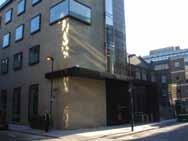
The Goldsmiths’ Centre was the largest single project ever undertaken by the Goldsmiths’ Company in support of the craft and industry. It included the refurbishment of an existing London Board School built in 1872 and the redevelopment of the brown field site alongside it in Clerkenwell, London. Now completed, it provides managed workspace, exhibition, conference and café areas. It houses the Goldsmiths’ Institute – a new education and training facility that provides a range of opportunities for those working, or aspiring to work, in the craft and industry.
I am pleased to be able to report that the new Charity established to run the site has
at last taken possession of the building and the staff team are now permanently based there. The run-up to Practical Completion, originally due in early October 2011, was not without its challenges.
A combination of factors conspired against the contractor and as a result handover of the site was delayed until Friday 3 February 2012, approximately four months late. This triggered a number of knock-on effects including delays to the mobilisation of the workspace, the café and Goldsmiths’ Institute as well as the events business centred on the exhibition spaces. Thankfully the Centre is now past the worst of this and, whilst there remain issues with the building,
life on site is gradually becoming more normal as tenants settle into their units and the building begins to take on a life of its own. The Centre was formally opened on 25th April 2012 by HRH Princess Alexandra. Throughout the redevelopment of the Eagle Court site, the Charity has benefitted from the guidance of an effective and knowledgeable Board of Trustees under the Chairmanship of Martin Drury. Martin completed five years on the Board in May 2012 and stood down having had a considerable impact upon the successful delivery of the Centre over this period. His replacement is Dame Lynne Brindley currently the CEO of the British Library and also a Member of the Court of Assistants of the Goldsmiths’ Company. Dame Lynne brings with her a wealth of strategic and management experience spanning the education and public sectors, and the Charity is delighted that she has agreed to take on the role. Other notable changes to the Board over the past twelve months include the departures in December 2011
backgrounds in marketing, promotion and education will bring a new dimension to the Board as the Centre goes live.
Operationally I was pleased to be able to report in last year’s Review that a great deal of interest had been received in the workspace on-site and this has proved to be the case. All but one of the larger leased units are now taken and an incredible mix of traditional and contemporary skills within the Centre has been achieved. Silversmiths, mounters, setter, engravers, casters, technologists (including computer aided designers and manufacturers), polishers and platers have been brought on board – all of whom have committed to contribute to the education and training remit of the Charity. As originally envisaged the Goldsmiths’ Centre is already beginning to provide a focal point for the craft and industry that both looks to the future and also values the skills of the present.
Our starter studios are also proving popular with four out of the nine available now licensed to young craftsmen and women.
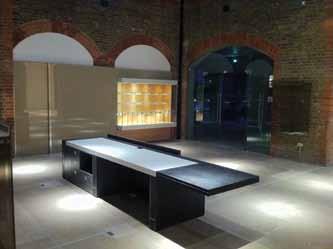
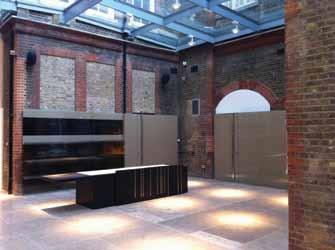
the Goldsmiths’ Centre is already beginning to provide a focal point for the craft and industry
of Rodney Melville and Julian Prideaux whose appointments were based upon their expertise and experience of the construction and development industries. As construction work finishes, they have been replaced with Heather Soderlind and Jack Cunningham whose
The next round of applications for these spaces will commence later in the year with the aim of having all of them filled by the end of 2012, with some of the candidates drawn from the Postgraduate Programme based within the Goldsmiths’ Institute.
The Goldsmiths’ Institute, the education and training
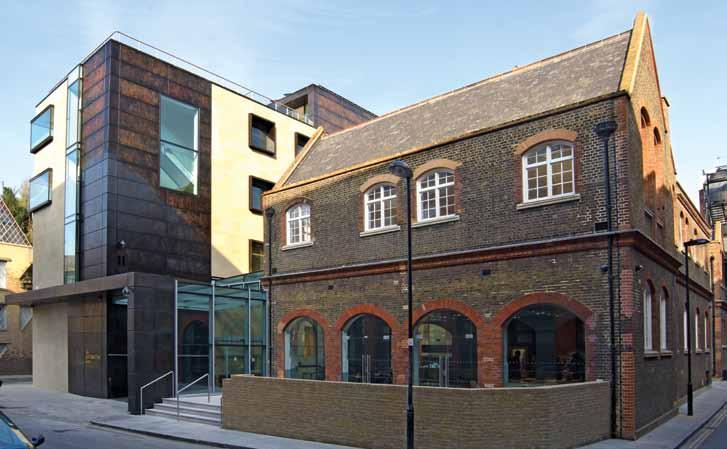
arm of the Centre, is now becoming active and the first cohort of postgraduates began their programme in February. Under the
programmes, and a number of important appointments in this area have been made over the last few months.
Under the leadership of stuart devlin, the Postgraduate Professional design Programme is the flagship course offered by the Charity
leadership of Stuart Devlin, the Postgraduate Professional Design Programme is the flagship course offered by the Charity. Each individual Postgraduate has access to a studio space and workbench during their time on the course and will benefit from expert inputs from a wide variety of visiting lecturers from across the craft and industry. The aim of the programme is to develop the future creative businesses that will help sustain the industry going forward. Work has also begun on the vocational training
The first is Robin Kyte who has joined as the Vocational Skills Director. Robin is a Cartier Award winning goldsmith and ex-lecturer with a wealth of experience to bring to the team at the Institute and Centre. He is joined by Kevin Wilson who for many years was the Technician – Demonstrator at University for Creative Arts (Rochester). The final member of the new Institute team is Helen Dobson who joined after completing her BA Design for Industry Degree at the School of Jewellery in Birmingham
Their aim is to launch the new Apprenticeship Foundation Programme successfully in autumn 2012 after completing the design, specification and fit-out of the spaces within the Institute. This will be complemented by a range of short courses for those working within the craft and industry. The aspiration is to become the centre for vocational and professional training for the sector in London; more information on the programmes can be found at www.goldsmiths-centre.org.
Likewise information on the Centre exhibition calendar can also be found on the website. The programme for 2012, overseen by Ruth Moir, the Exhibition & Events Manager, includes the opening exhibition scheduled for April celebrating the redevelopment of the Centre and the work of the
Goldsmiths’ Company in support of the craft and industry. This will be followed in June by an exhibition celebrating the Diamond Jubilee in collaboration with the Association for Contemporary Jewellery and a selling exhibition with British Silver Week in July. The calendar from 2013 onwards is also filling up with what it is hoped will be an interesting, challenging and diverse programme of events and exhibitions that underpin the purpose of the Charitable Trust. The Trustees have agreed that, where possible and appropriate, the majority of the Centre’s exhibitions will last around two weeks in order to maximise the opportunity represented by the space at its disposal. Positively the events space is also now beginning to generate interest, and a decision has been made to name the fourth floor space after Agas Harding whose gift of land some centuries ago enabled the construction of the Centre to take place.
An active programme of events and exhibitions will also mean that the café is well used by both trade and nontrade visitors to the building. Access to the terrace will mean that visitors should have a pleasant environment to enjoy a bite to eat or a drink whilst taking in an exhibition or event. The quality of catering at any site is always important and the Trustees were delighted to be able to appoint Ampersand as the Centre’s catering partner. Its parent company also successfully bid for the Goldsmiths’ Company’s

catering contract so hopefully both will benefit from this association.
The Goldsmiths’ Centre is now entering its most exciting phase. Whilst the construction project has been challenging the way in which the facility will be used is key. I for one am relishing this prospect and am looking forward to working with the Trustees and the team at the Centre to make this ground-breaking investment in our craft and industry a great success.
By Eleni Bide
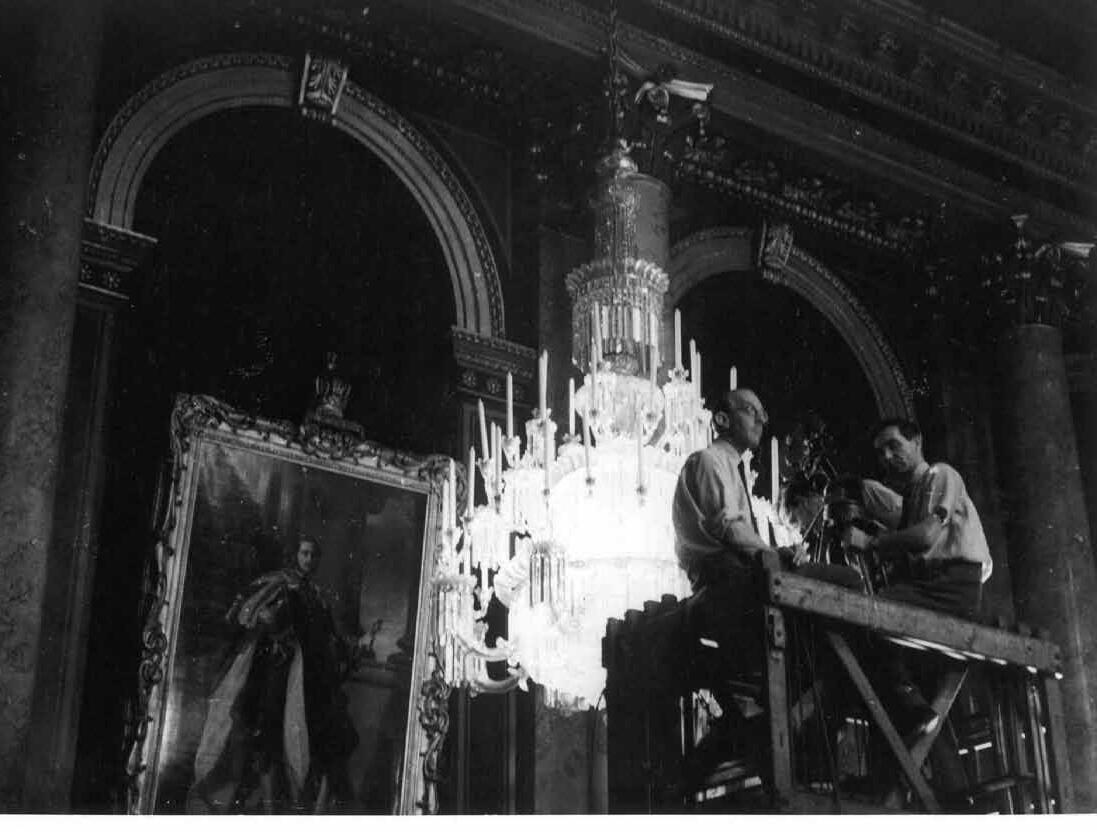
British cinema in the mid20th century conjures glamorous names like Alec Guinness and Jayne Mansfield. However rediscovered material from the archives vault shows how in 1960 the Goldsmiths’ Company joined them as an unlikely star of the silver screen. The Company’s involvement in the film
industry had begun much earlier. In 1938 it collaborated with the bullion firm Johnson Matthey to make a short black and white film, Silver, its craft and traditions This focussed principally on technical matters, although the Company’s history was touched upon briefly. It was shown extensively in schools and colleges, and by the 1950s the surviving prints
had become badly worn.
As the original negative had been destroyed by war-time bombing, the Court of Assistants faced a decision on whether to commission a new film.
During April 1955 members of the Court spent some time wrestling unsuccessfully with problems such as black and white versus colour and the
Sir Michael Balcon. Most importantly it resisted the temptation of cheaper offers from more prosaic film companies and, on the recommendation of industry insiders, asked Basil Wright’s Realist Film Unit to undertake the project.
Wright has been described as ‘the humanitarian poet of the British documentary movement’ and many of his films are still highly regarded. Their defining features are a mix of practical information and poetic vision, and his correspondence with the Company shows the importance he put on imagination and atmosphere.
He was formally commissioned to prepare a treatment for a film on 16 November 1955. His initial brief was squarely tradeorientated, and included points such as ‘to recruit good boys to the trade’. It was decided to build the film around the life of an apprentice and the surviving scenario shows how information was to be conveyed through plots involving the young man’s love life and dream sequences.
hoping to spend around £18,000 on the project, but the Film Committee eventually persuaded the Court to approve a budget of £26,000. All recognised that ‘It was vitally important that it should be interesting; it should be an imaginative and exciting treatment of a subject which has never been filmed’. Economising would put these aims in danger.
Filming itself took place over the summer of 1959.
Surviving papers provide a fascinating insight into how a documentary was made during this period, with detailed costings and requirements for cast and crew. Initially Basil Wright asked for candidates to play the apprentice: ‘he should be an attractive person in every way, good at expressing himself, and a working representative of the trade’.
Evidently none of the Company’s apprentices were sufficiently dashing as an actor was eventually paid £80 to play this part.
Librarian, Susan Hare, came up with the winner, based on a biblical quotation which had adorned the Livery Hall.
A Place for Gold was finished in April 1960, in time to be shown at the British Exhibition in New York. Its first commercial showing was at the Warner Cinema in Leicester Square, where it accompanied the controversial SaturdayNight andSundayMorning, starring Albert Finney – an unlikely pairing which delighted the Wardens due to the exposure it brought.
Although distribution by commercial cinemas in the UK was limited, it proved very popular with educational institutions and copies were requested by organisations in countries throughout the world, including Switzerland, South Africa, Australia, Canada and Brazil.
Poignantly, it was Basil Wright’s last picture. As such it earns a place in British film history, as well as the history of the Goldsmiths’ Company.
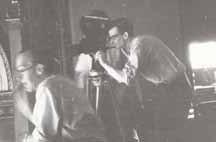
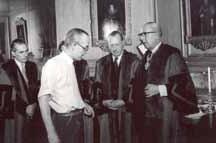
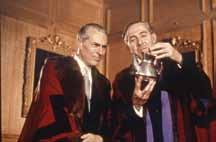
its first commercial showing was at the warner Cinema in leicester square, where it accompanied the controversial saturdayNight and sunday morning
role of television. Eventually ‘in view of the complexity of the problems involved’ it was decided to appoint a subcommittee to look into the matter. This proved to be a very good idea: chaired by G.C.H. Matthey, the committee was energetic and persuasive. It championed the project and sought the opinion of industry figures including the respected producer
However when the Court was presented with the Film Committee’s work in June 1958, it decided to change the focus to the prestige of the Company itself. Another treatment and script was produced by the Oscarwinning scriptwriter Paul Dehn. Still featuring an apprentice, but in a much reduced role, it explored through a series of vignettes aspects of retail, manufacturing, hallmarking and the Company’s history. Making such a film would be expensive: early documents suggest the Company was
Compromises also had to be made over the opening sequence. Wright envisaged a glittering ball scene, however this was costly and carried implications of extravagance. He wrote ‘by beating my brains to the consistency of butter, I have evolved an alternative opening sequence’, involving torch-light playing across a dark and mysterious Goldsmiths’ Hall.
The film’s title was not decided until February 1960.
Basil Wright suggested ‘Realms of Gold’ but the
A recent collaboration with London Screen Archives revealed that the Company owns the only known complete version and the original negatives. With the help of film expert David Cleveland this fragile and unique material has been pieced together, conserved and digitised. Now, for the first time in decades, viewers can rediscover the cinematic glamour Wright brought to Foster Lane.
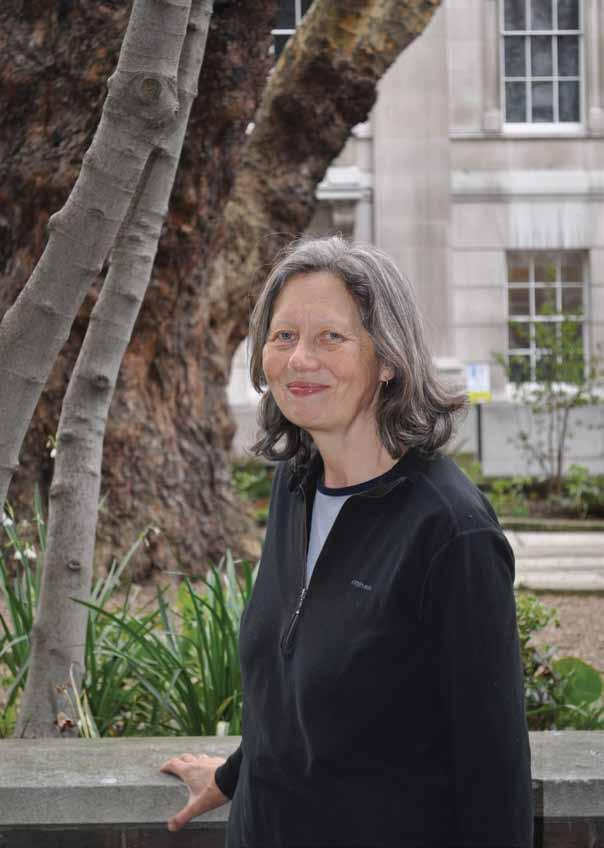
By Sue Madden
Following a Diploma in Fine Art, my first career was as a dealer in antique textiles. The Goldsmiths’ Garden, to the north of the Hall, was my first gardening job and has lasted 17 years.
The garden has a beautiful structure, designed in the early 1960s by the landscape architect, Sir Peter Shepheard, and is a close relation to his garden on Cheyne Walk. It is a modernist garden, although,
to me, it is like an Arts and Crafts garden because of its beautiful detail and natural materials. The walls are handmade red brick with a repeat pattern of bird-boxes, deep piers and lighted arches, with Portland stone coping, York stone paving and steps with a ‘Chinese channel’ bordering them to aid sweeping and granite sets surrounding the lawn. The walls, built around the garden and against the street, give a double height to the lower garden, creating a deep and sheltered sunken garden, protected from city wind tunnels and muffling the sound of the traffic and the constant re-building of the City. Shepheard imagined passers-by would lean over to look into the garden with their elbows resting on the wall.
The design of the garden creates an atmosphere; Shepheard would have called it geniusloci – genius of the place. The design evokes an earlier place: a bomb-site tended by Goldsmiths’ staff in the Second World War or the crypt and churchyard of the church of St. John Zachary, which was burnt down in the Fire of London. The garden consists of two and a half levels. The top seating area has grave stones emerging from the gravel. Two magnificent London plane trees provide deep deciduous shade, which can be at a premium on hot summer days in the City, and gives cover to the gardener and others sheltering from rain. They also provide scale to the garden, like a cathedral stretching upwards over one’s head. The street level of the garden consists of pathways and borders
drawing one in from the street and leading to the steps and the lower, sunnier walled garden, with benches, narrow borders and the large square lawn with its central fountain.
Looking out of the garden, between shrubs planted to enclose and protect the garden, as well as enhance the street, are lovely views of its neighbours: Goldsmiths’ Hall across Gresham Street; the Wax Chandlers’ Hall; the church of St. Anne and St. Agnes; and these stay as constant friends in the ever changing City. Shepheard was a great naturalist and his design for the garden suited a natural planting style. I was given the opportunity by the Company to replant the garden in 2003 after the disruption caused by the erection of the Lloyds’ building. The garden is on two levels, which is very exciting and is a gift to any gardener with vision. I especially loved planting shrubs in the beds under the plane trees which overhang or droop into the lower garden – such as the huge cascading Jasminum nudiflorum (winter jasmine), or the cut leaved Acer aconitifolium, planted above the steps and jutting out above the lower garden as if from a rocky crag.
The soil, in spite of its annual mulching with wellrotted manure, is thin and slightly alkaline. The beautiful Magnoliasieboldii (illustrated), which welcomes you at the entrance to the garden, tolerates these conditions. Light levels in the garden were encroached upon by the expanding plane canopies and the renewal of buildings.
Under the canopy of the plane trees, plants which enjoy woodland deciduous shade included an annual order of bulbs such as wood anenomies, snowdrops including Galanthus nivals, G.n.florepleno and G.n. elwesii, winter aconites, crocus, narcissus, Spanish white bluebells as well as our native bluebell, Leucojum –winter snowfla kes, scillas,
cleaning of the paving, necessary for aesthetic as well as safety reasons; the plane tree leaves with their unseasonal summer-drop and seed balls bursting just as the garden was looking at its best. In summer the garden could be crowded with people on every surface which made it necessary for me to adjust my routine. Winter could be uneventful or

Jeffersonia dubia and Cyclamencoum and hederifolium
As with all gardens, there have been the usual pest and disease problems, such as aphids and mildew. Visits might be made by a solitary squirrel; pigeons finally discovered the bird-feeders
lonely, but in spring I looked forward to the blue tits chattering in the wall as I passed or swooping to their nest-holes with something delicious in their mouths, or the odd pair of mallards en route to the Barbican. The more orderly I could make the garden in winter, the more
shrub, Decaisneafargesii, with its delicate racemes of limey yellow flowers followed by long blue metallic pods had many admirers. The Cup-and-SaucerVine, Cobaea scandens, an annual climber with mauve nodding cups and seed-heads, planted on the south-facing wall, over wintered and covered the length of the wall. This always brought people down to enquire or to admire or to ask for seed.
The Magnoliagrandifloras, with their sculpted white flowers, scented the garden with their lemony perfume. Latterly, there has been the addition of The Three Printers sculpture by Wilfred Dudeneys which has fitted so well into the garden. Their welcome presence meant that I was never really alone. I love the garden and greatly enjoyed looking after it for the Company, the City and its inhabitants. Although retiring from this garden I am still kept busy gardening at Lambeth Palace where I have been the deputy head gardener for sixteen years. I am also keeping a presence in the City as I look after the garden of the Girdlers’ Company around the corner from the Hall. I am very happy to have left the Goldsmiths’ garden with James Cable, its new
in spring i looked forward to the blue tits chattering in the wall as i passed or swooping to their nest-holes with something delicious in their mouths, or the odd pair of mallards en route to the Barbican
intended for the blue tits or blackbirds; and unwanted dogs were discouraged as were visitors of the human kind who dropped their cigarette-butts as I was picking them up!
Working in this City garden could be arduous: the annual
stimulating and beautiful it became in summer – and the more likely I would be to attract dialogue or compliments. By choosing dynamic or unusual plants the garden would create pleasure and curiosity for the passers-by. The beautiful
guardian, and I look forward to seeing it flourish and develop in his hands and with his vision.
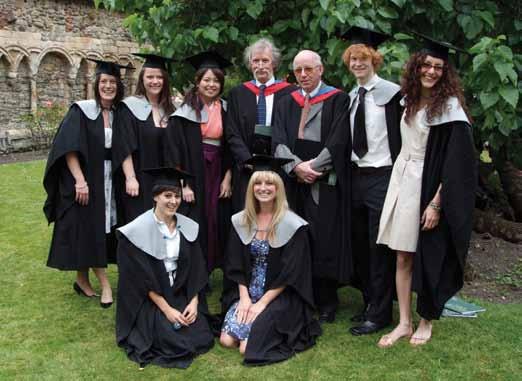
By Stephen
On the last day of the summer term last year, Brian Hill, Head of the Silversmithing, Goldsmithing and Jewellery Department (SG&J) of the Rochester campus of the University College for the Creative Arts (UCA), and an extraordinary teacher, cleared the desk of what had been his office for almost four decades, thirty-nine years to be exact.
Over that time Brian, or ‘Sir’ as I used to call him, has been responsible for teaching, nurturing and, consequently, introducing literally thousands of students from all over the world to the
industries of silversmithing, goldsmithing, jewellery and allied trades.
I am fortunate to count myself amongst that number.
After the unforgettable and now iconic summer of 1976, I entered the pre-apprentice course at the Medway College of Design and Technology. I remember there being little or no time for acclimatisation – first lesson first day, diamond mounting with tutor Mr Hill. I had, until that point, been at Springhead School for Boys in Gravesend where teachers were, on the whole, to be feared. Mr Hill did not appear
to be frightening but then again appearances could be deceiving. Brian was young – only a few years older than his students, he was firm with what appeared to be a fixation with precision, accuracy and craftsmanship. “Oh yes and the shocking price of not gold but piercing saw blades”. By day two I had developed a respect for the currency value of piercing saw blades and, more importantly, the reasons for Brian’s fixations.
While Brian and I were having a coffee and chatting about this article, I reminded him that he had made me start my nine-stone cluster (a required test piece) from scratch no less than eight times. Funnily he could not recollect it being more than five times but I know I am right on that one. At the time I believed Brian had it in for me but I soon understood that this was how craftsmanship was taught – and learnt.
Eventually completing that nine-stone cluster, the thirteen pre-apprentice students, myself included, went on more adequately equipped to continue our ‘on the job training’ and apprenticeships within the jewellery and silversmithing trades.
As an example of a person who can both make and teach, Brian was noted very quickly by his tutors as a student who possessed exceptional skills as a jeweller. Indeed by the time he entered his third and final year of
his course at Medway he was offered a part-time position teaching the first year students – quite an achievement.
After leaving college Brian’s skills were in demand. The high end London trade had caught wind of this new talent. He was employed by T. O’ Donoghue, the firm of traditional diamond mounters, known for the exceptionally high quality and complexity of their work. He also worked for David Thomas, one of the most influential contemporary designer jewellers.
Finding his place comfortably within the industry he loved and applying and continuously improving on his natural skills, Brian was all set to enjoy what he thought to be a long career ahead. That was until, out of the blue, came a call from his tutor/mentor,
Bob May, Head of the SG&J course at Medway College and one of the most respected silversmiths in the UK. He offered Brian a fulltime position as a jewellery tutor. The role was primarily to lead the pre-apprentice course. This was a real dilemma for the 22 year old. After much deliberation and parental consultation Brian, fortunately for many of us, chose the teaching option.
Over the following years Brian established himself as an exceptional teacher and eventually became the head of a department with
responsibility for 150 students at any one time. Always enabling, he in turn expected each and every one to learn so that they could realise their full potential.
Unlike many in his position Brian always kept his finger
to become invaluable to an industry keen to find new momentum. Brian also said that the key to achieving the successes on the SG&J course was having a great team of designers and craftsmen
appointed as Consultant Secretary to the GC&DC. Perhaps the single thing he is most excited about is his involvement with the new Goldsmiths’ Centre. Along with many people with a passion to preserve
Brian established himself as an exceptional teacher and eventually became the head of a department with responsibility for 150 students at any one time
on the pulse of the industry. This has been essential in keeping his stream of graduates relevant in an ever changing world.
I asked Brian if he found the rate of technological change within the industry at all frightening or did he embrace all advances in whatever form they took. He gave a very honest answer. At first it had not been easy for him to accept that CAD (computer aided design) could potentially render redundant some of the fundamental skills he possessed and had consequently been passing on for so many years. This fear soon turned to enthusiasm for what was to become the single greatest advance in an industry which had been conducted using the same basic tools for centuries. Brian knew there was no going back. He had seen the future and it inspired him. Within no time at all the students on the SG&J course were being encouraged to learn CAD, equipping them
working alongside him, and none more so than his stalwart colleague, John Cruse. As well as his day job Brian has always maintained strong links with the trade at large.
For over 20 years he has been a member (and Chairman twice) of the Goldsmiths’ Craft and Design Council. Brian has always required his students to take part in the GC&DC competitions. He recognised the opportunities of taking part – winning an award can reward an exceptional talent early on in a career. This has more than paid off. UCA (formerly Medway College) has won the prestigious College Trophy 19 times over the last 21 years.
At almost bus pass age, Brian may have hung up one educational hat but has no intention of taking up lawn bowls or indeed gardening. He is writing a book, A contemporaryguideto silversmithing, in collaboration with Andrew Putland. In May, Brian was
the skills vital to the future of the gold and silversmithing industries in the UK, Brian has championed the prospect of the Goldsmiths’ Centre. He will be sitting alongside Peter Taylor on the newly formed Craft & Industry Committee to oversee the work and programmes of the Centre. This really is the perfect environment for Brian to continue to contribute his wealth of skills and experience, thus helping to maintain the high benchmark of excellence so essential in the world today. With luxury brands refocusing on craftsmanship, design and authenticity as the points of difference between themselves and mass produced products, Brian will be striving to keep jewellery where it truly belongs.
By Melanie Eddy - Coordinator for Hothouse: The Goldsmiths’ Institute
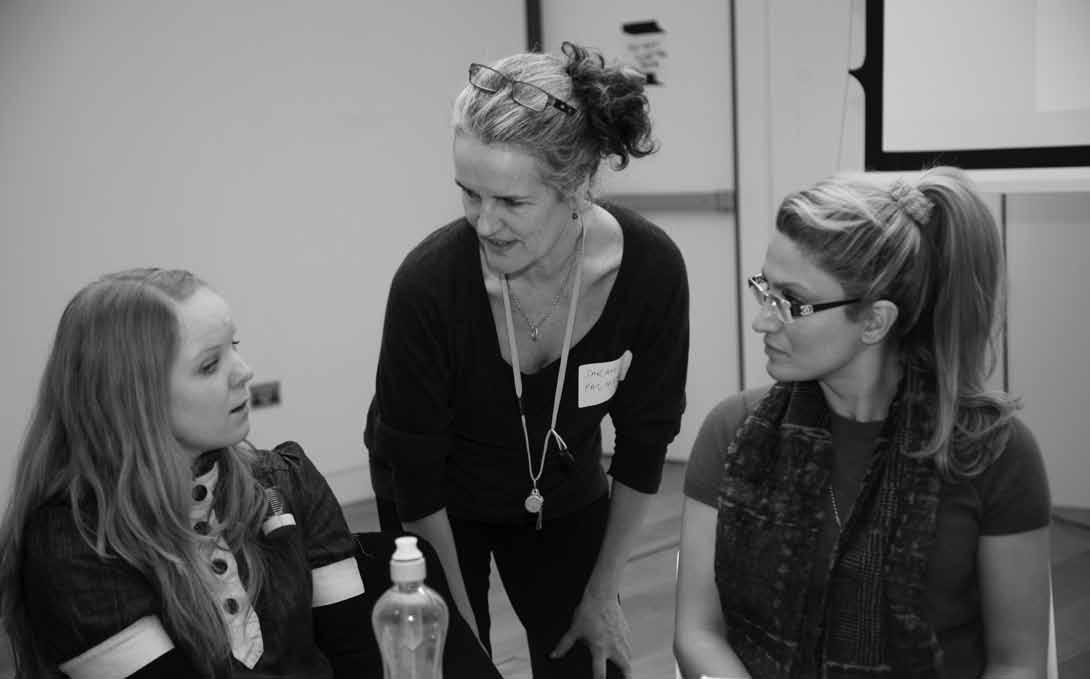
Recalling the apprehension and excitement of establishing my own jewellery practice after college, I accepted with interest the role as coordinator of a new creative and professional development programme last May.
Hothouse: The Goldsmiths’ Institute was a Crafts Council programme, delivered in partnership with the Institute, for emerging makers which was especially tailored for recent recipients of support
from the Goldsmiths’ Company. I was excited by its potential benefit to makers at a crucial stage in their career development.
Makers within two years of setting up a practice or from graduation were provided with a programme of focussed, intensive business skills and creative development, complemented with one-toone support over a six-month period. Eight very individual makers were brought onto
the programme; Kevin Brook, Hannah Dennis, Mahtab Hanna, Zehava HashaiSpellman, Elizabeth Auriol Peers, Helen Smith, Victoria Walker and Janice Zethraeus, all with different approaches and outlooks.
The core programme was shaped throughout for the group with members of the industry brought in as speakers, panel members and mentors. This included gallery owners, retailers,
the transformation in the group from the interview process through the training sessions has been remarkable
creative directors, established designer/makers, and representatives of the BJA and British Silver Week. Makers were approached to provide peer support, sharing their recent experience of setting up a practice for the first time. Many of those who took part in supporting the programme are part of larger organisations such as the Association for Contemporary Jewellery and Contemporary British Silversmiths. Individuals from other sectors joined to advise, support and engage the participants in areas such as PR and marketing, writing, and business and financial planning. Links were made with retailers and galleries in London to assist the group in conducting research into the market and audience for their work, with a day spent visiting key retailers and gallerists in London.
The transformation in the group from the interview process through the training sessions has been remarkable. They are more assured of their position, more confident and proactive, and more articulate in speaking and writing about their practice. As they gained more insight into the running of their business they have been making informed choices regarding their creative development. They now understand that their creativity and design prowess can be put to work to map out the future that they want for their creative practice, and that there is no one right way of doing this. Working with
this group has given the Institute a more intimate connection to makers at this stage in their careers. It has allowed a glimpse behind the protective veneer of ‘putting up a good front’ and to understand better their concerns, fears and challenges.
During the programme, subjects ranging from bookkeeping and design development to raising one’s profile through social networking have been covered. Writing workshops were undertaken, elevator pitches were fine-tuned, and furious discussions ensued on the appropriate catch for a new piece or how to incorporate gemstones into an existing collection. Since starting Hothouse, some participants have made their first forays into working in 18ct gold, others are considering tackling platinum by entering the Lonmin Design Innovation Award, the annual platinum jewellery competition for jewellery designers based in the UK.
Four of the eight participants showed work in the exhibition of the Goldsmiths’ Craft and Design Council Awards, all receiving awards or commendations.
A commission for plate for a City livery company is being undertaken as I type.
The 2011/2012 programme had three cohorts; the jewellery and silversmithing cohort, a textile based cohort in the South West and a mixed discipline cohort in the North. Each cohort was run in partnership with specialist
organisations to devise and deliver unique training programmes and all three groups met at points throughout the programme for networking, peer support and reflection. One of the highlights was a peer networking event at the craft organisation Designed & Made in Newcastle. The whole group underwent ‘Pecha Kucha’ style slide presentations in which they had a few minutes each to talk through three images representing something from their past, something which represents where they are right now and an image to represent where they would like to be in five years’ time. The day included the group splitting off to view local exhibitions including the Turner Prize at the Baltic and a permanent glass installation at the Sage Gateshead. Of course the final session was greeted with increased excitement by the Goldsmiths’ Institute cohort
who welcomed the other groups to the new Goldsmiths’ Centre for the Reflection day, which also happened to be the first event hosted in the new exhibition room at the Centre.
Hothouse has brought together emerging makers, from around the country and from different disciplines, for a focussed programme of creative and professional development and it has engaged these makers in critical discussions surrounding their practices and their businesses. Although this is a challenging time for new businesses, it has been very inspiring to see individuals meeting those challenges head on. It has shown me that the British jewellery and silversmithing industry, although a very established tradition, has new talent coming through which is transforming the way that precious metals are being crafted, worn, viewed and adored.
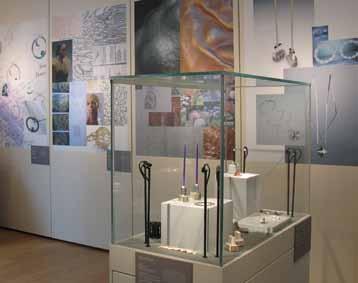
By Corinne Julius
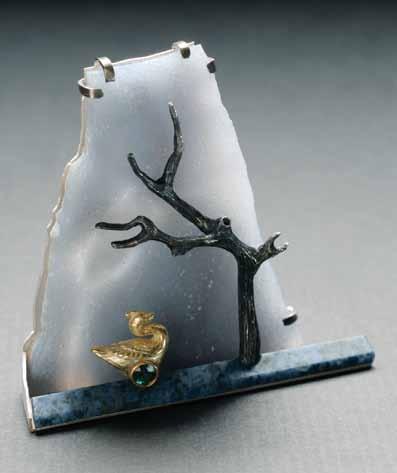

Barbara Christie is a jewellery lover’s jeweller. A regular at Goldsmiths’ Fair, she is an immensely inventive designer and also a teacher and enabler. Her work combines narrative, humour, and technical innovation with a love of stones and is characterised by a sensitive understanding of form and colour. She prides herself that her work is every bit as enticing and well made on the reverse, as it is on the front.
Barbara Christie did not set out to be a jeweller. Her first love was drama and a sense of
theatre is inherent in her work.
From the age of six, Christie dreamed of a life on stage, attending drama school in her native Amsterdam.
Making however was always to the fore, and she became involved in creating accessories and props for a fringe theatre group. Her interests in design and craft were inspired by her parents.
Her mother was a pattern maker, who made elegant clothes and dolls for her daughter, and her father, an interior designer, owned one of Amsterdam’s leading design stores, ’t Woonhuys.
“I was,” she says, “always surrounded by beautiful and well-made objects. I was encouraged to look from an early age and to be observationally aware.
” This ‘deep looking’ is at the core of her work.
Christie’s father was constantly bringing new objects into their home, pointing out to his daughter the interrelationships between artefacts.
This interest – in changing dynamics and a delight in experimentation – has been a tremendous influence on her work.
Barbara Christie came to live in England in 1969 and married the architect, George Christie, in 1971. Shortly afterwards she started adult education classes at the Sir John Cass College and soon
became deeply involved in jewellery making. “I was taught the old fashioned way by a Swiss watchmaker, who used to reduce me to tears. I really had to learn how to make properly and to be meticulous. What I really learned (building on what I had learnt at home) was how to look hard.” She enrolled at the Cass part time, and then received a two-year settingup grant from the Crafts Council. Her success was rapid and by 1978 she had had one woman shows at Electrum, The Oxford Gallery and the Arnolfini in Bristol. Her early work was all figurative, with both a pronounced sense of movement and a strong narrative element, much of it based on the circus.
The imagery included everything from tightrope walkers to seals with balancing balls. This love of narrative persists; she uses her jewellery for commentary and storytelling, often creating a series of brooches, over which a sequence of events unfolds. Her Nun brooches (2002) start with a nun with a suitcase mounting church steps. In the second brooch the nun, still with her suitcase, is being expelled from the church and in the final brooch the nun emerges as a married woman picking up the suitcase to go off on her honeymoon.

Such humour is an important element in her work. “It has to have humour. You can’t sit still all day, which you have to do as a jeweller, without it,” laughs Christie. “It’s incredibly important.” Often the humour is gentle and wry as in her series in 1994 portraying different shops and their contents in minute form or her birds complete with mossy nests and eggs (1977). Her humour does not preclude more serious comment. Her trio of brooches (2002), based on the rising price of a jeweller’s raw materials, show, in turn, the state of the stock market, drilling for diamonds and the upward movement of the gold price.
In the past the format for her brooches was often the box or window shape, which allows Christie to indulge her love of theatricality. “The box has a secret, you can play around and manipulate it as a container for a story or narrative,” explains Christie. Windows perform a similar role. Much of her work goes back to being taught to look.
devising her own techniques and tools, using everything from engraving and repoussé to inlay and damascening.
“I love etching, it gives you an instant image,” she enthuses.
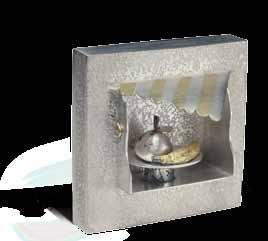
“Metal is so exciting.” She works in a variety of precious and non-precious metals. A particularly successful series was her MarriageofMetal brooches (1984), using inlay of different metals to produce distorted Escher-like chequer board effects.
sugar. “I might have to stop working with them because they have now become so ubiquitous,” she says sadly.
A current favourite is opals.
“I have worked a lot with opals. They are so mysterious, like an inexplicable world.”
She amasses visual cues, which come together in new ways, for example her Monk brooches (1996) where the church is clearly based on a design by architect Tadeo Ando. The decorative elements include mirror and slate. The latter can be taken out and replaced with an alternative decorative surface. The brooches highlight Christie’s appreciation of space, light and reflection and illustrate her architectural understanding and manipulation of space and form.
Colour is an essential element of her work. Her early pieces used different metals enhanced by ivory, wood, titanium and cold enamel, but increasingly the colour comes from stones.
Christie now buys most of her stones at Inhorgenta. “I look for a quality and difference in a stone; i.e. the cut, the grain and I think inclusions are beautiful and show that the stones come out of the earth. It shows the purity of the material and I really want to show respect for that. For me it is such a thrill. I love learning about the stones, finding different ways to use them and getting them to show their best potential.
this love of narrative persists; she uses her jewellery for commentary and storytelling
Not all her work has an immediately obvious narrative, but even her more abstract pieces rely on the story she is telling herself. They also depend on Christie’s love of technical experimentation. She likes to set herself difficulties to overcome. “I’m mainly home taught. I just love figuring things out.” She enjoys
Christie has been extremely influential in introducing tension-set stones in taut modernist settings, and the use of large flamboyant nonprecious stones or stones with unusual cuts. For the last eleven years she has experimented with assembling striking stones in long necklaces and collars as well as in dramatic rings, brooches and earrings. She was an early fan of lapis lazuli.
“The colour is so important and the inclusions of pyrites gives such fantastic colours.
I really use the inclusions,” she enthuses. She has led the current fascination with Drusy stones. These are often chalcedonies with encrustations or minute clusters of crystals that look like a light dusting of snow or
The form of stones is very important to me. I don’t use regular stones, except diamonds. I use a lot of agates and river pebbles. I get inspired by the stone; the stone suggests or dictates the piece. It is tremendously exciting. I look at the stone and sit with it. Then I have an
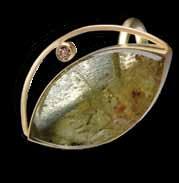
idea and just sit with that. I can’t draw but I have pages of sketches of stones,” she explains. She often works in three month stints, playing first with her found objects and stones; assembling and reassembling them; sketching designs; and creating models to give an idea of scale or to work out technical hiccoughs. This is followed by an intensive three month burst of making.
For the Goldsmiths’ Power and Allure exhibition she has made a graduated neckpiece of 40 Drusy stones in shades of grey, overlaid with gold and scattered with gold dust. “It’s very exciting working out what I can combine, the colours, the aesthetic of things. It is very personal. I work out what I like. It is all for me and I just hope that someone else will appreciate it.” They invariably do. Christie has a significant and committed following, which is attracted to her striking, bold but immensely wearable pieces. Her designs are daring and colourful and she is currently using found objects and carved stones in the form of human or animal heads, mounted to theatrical effect. She does not repeat her designs. “Experimenting gets my creative juices flowing. It’s very rare that a piece doesn’t work out if I persevere,” she says, “although I’m not necessarily happy with it. I’m always
going off on a different tangent. I never go back to a theme, I move away. I have a low boredom threshold.
It’s very important to me to get out of my comfort zone. I can’t even make two earrings exactly the same.”
This approach involves considerable financial risk;
commentators that she deserves and is surprisingly unconfident about her own ability and status in the jewellery world.
Her commitment to teaching has also affected her acknowledgement by craft commentators. Christie has been a devoted teacher, spending 20 years teaching undergraduates at Central St Martin’s (1991-2011), and 33 years at Morley College (1976-2009), where she turned on several generations to jewellery making and, just as importantly, to collecting.
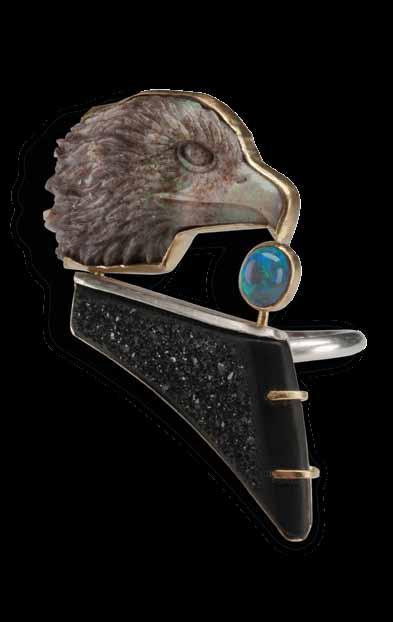
clearly her own. Whilst she has devoted clients she has not had the professional recognition by so-called
After 25 years she continues, despite her current illness, to teach at West Dean and to tutor a select and fortunate band in her own studio.
At least 50% of her time has been spent teaching, in part because she loves the drama and ‘giving’ of teaching, but also for the stimulus it offers her. This love of teaching extends to her prolific commissioned work. She often designs alongside a client eliciting their thoughts and explaining her own.
Christie describes her work as “bold and direct, but always deceptively simple.”
Her pieces are always striking but always wearable as her army of collectors attests.
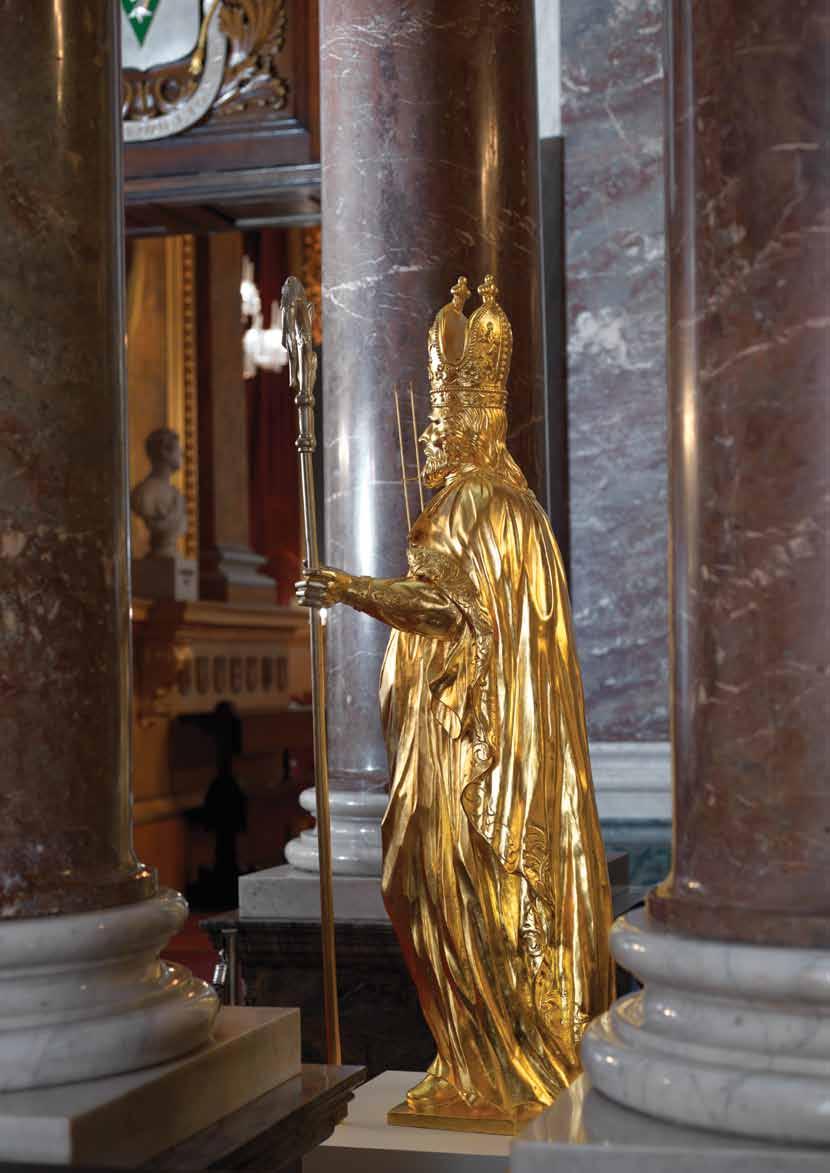
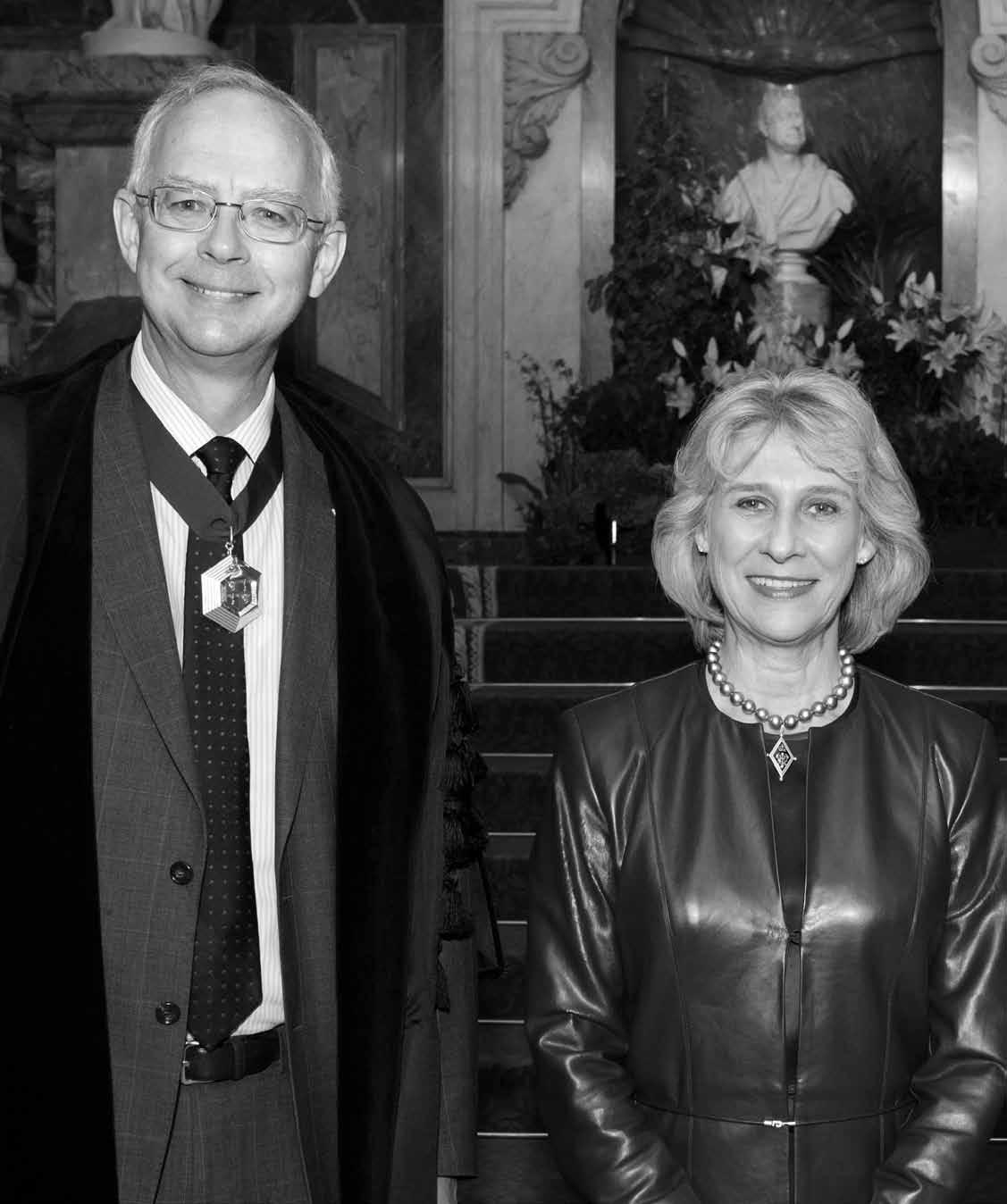
By Dick Melly
The last 12 months have been characterised by the unrelenting pace of change and the inevitable challenges that have arisen. Whilst there have been highs, such as the exhibitions, the Goldsmiths’ Fair, and the Livery events, there have also been some more interesting times with issues to be addressed such as the dire hallmarking environment, delays to the completion of the Goldsmiths’ Centre, and the continuing pressure on the Company’s corporate and charitable finances.
Starting with developments with the Court, the four new Assistants elected in 2011 have had the opportunity to find their feet. Additionally, the arrangements for the Corporate Trustee of the Company’s charities are maturing in the light of experience; this latter initiative has far-reaching consequences and is a necessary improvement to the overall arrangements for the governance of the Company’s charitable endowments.
The Assay Office is still operating in a particularly difficult hallmarking environment. Nevertheless, the Deputy Warden has had considerable success in addressing some of the underlying issues: costs have been tightly controlled; the hallmarking pricing structures have been adjusted; and there has been some success in efforts to diversify the services on offer. This gives ground to believe that the storm can be weathered, even in the light of a further decline in the number of articles presented for marking. The purchase of a ‘punch making’ laser has been particularly satisfying, and this significant investment in the Assay Office’s capabilities means that, for the first time in modern times, it is now able to manufacture all of the punches required. Efforts are also being made to make better use of some of the Assay Office’s other strengths, particularly with regard to expanding both laser marking services (punch making and bespoke designs) and also laboratory offers (e.g. smelting).
The roller coaster of a project to establish the Goldsmiths’ Centre in Clerkenwell has kept staff and Trustees alike very busy. Initially due to achieve Practical Completion in October 2011 (itself a slippage of six months following the original prime contractor going into receivership), this important milestone slipped by a further four months. This was immensely frustrating for all concerned and meant a delay to the start of the programmes intended to be delivered from the facility. Practical Completion was finally achieved on 3 February 2012 –and the first course for six postgraduates in the Goldsmiths’ Institute began just five days later. This flagship programme, under the guidance of Dr Stuart Devlin, is planned to run for ten months and will enhance the ability of the postgraduates to run successful businesses in the future. With the Centre now handed over to Peter Taylor, the Director, and his newly recruited team,
the real business of bringing the Centre to life has started. This necessitates a partnership between all involved (the Centre’s staff; the workshop licence holders; the caterers; the postgraduates and those taking courses in the Institute; and other users of the Centre’s facilities) to ensure that the Goldsmiths’ Centre makes a very real difference to all those who use it. Despite the increased costs associated with the delays to the project, it is gratifying to report that, under the firm guidance of the Chairman of Trustees, Mr Martin Drury, the project has been delivered within budget and to a satisfyingly high specification. If you have yet to visit the Centre, then I encourage you to pay an early call.
The Company’s finances have continued to be beset by the vagaries of the wider financial crisis. Whilst the Company has considerable resources and remains in robust health, the drop in income for the Goldsmiths’ Company Charity has been keenly felt. The capital costs of constructing the Goldsmiths’ Centre have largely been met from the legacy generously given by Agas Harding some five centuries ago, but provision has necessarily had to be made to support the Centre over the early years until its own income streams develop. Once again this has meant that the Court has been faced with some unpalatable choices, but the priority has rightly been to ensure that the ability to make donations in the future is not prejudiced by drawing too much from the endowment in the present.
A welcome source of additional income has been derived from the Hall. The new caterers, Chester Boyd, took over at the start of August 2011 and have had some success in bringing in additional business. Additionally, a film location company has been engaged to advertise the Hall’s attractiveness as a site for filming. This has resulted in some high profile exposure in recent films (e.g. Sherlock Holmes – film and TV series, and TheGirl withtheDragonTattoo). This increased activity has kept the new Hallkeeper, Richard McCrow, and his team very busy, but they have enjoyed meeting many of the more famous visitors who now routinely grace the Hall. I personally feel that it is the new and rather grand stairway carpet, installed in summer 2011, which has accounted for the Hall’s sudden popularity as a location for filming – but others feel it is the splendidly refurbished statue of St Dunstan which has led to this change in the Company’s fortunes!
One particularly interesting strand of work this year has been led by the Deputy Clerk. In his capacity as the Secretary of the newly formed Membership Committee, he has had the task of developing the initiatives around Company membership and selection to the Livery. One of the purposes of the Membership Committee has been to seek to engage more closely with the
Company’s large membership of approximately 1,800 individuals. This is to ensure that those who wish to contribute to the Company’s work have the opportunity to do so both through direct involvement in the Company’s many activities and also via the recently introduced ‘charitable giving’ scheme. This latter initiative has had an encouraging start and the generosity of some has been heart warming - but there remains much to do to encourage more of the Company’s membership, particularly those who have benefitted from the Company’s largesse in the past, to contribute more to this worthy cause.It is salutary to recall that the only reason that the Company is endowed today is due to the generosity of its membership in earlier times.
The more routine, but nevertheless important, aspects of Company life have continued unabated. The Apprenticeship Scheme currently has 22 young men and women studying with Masters for periods of between three and five years. Recently, the Company has been instrumental in the production of National Occupational Standards for silversmiths and jewellers, and this will have far-reaching ramifications within the Further Education sector where students will in future be able to achieve National Vocational Qualifications in these subjects. The Company has remained in the discerning public’s eye with two acclaimed exhibitions staged by the Promotion Department (Jacqueline Mina and Mindful of Silver), a successful Goldsmiths’ Fair and, a new departure, a Goldsmiths’ Pavilion; meanwhile the Curator’s Department has staged a small exhibition at the Hall featuring The Corieltavi Bowl and the second of the National Trust’s Artist in Residence placements, this time featuring Theresa Nguyen at Kedleston Hall.
it is salutary to recall that the only reason that the Company is endowed today is due to the generosity of its membership in earlier times
None of this would be possible without the efforts of those who provide the essential backup, albeit often unseen. Significant work is being undertaken by the Accounts Department to introduce a new accounting package as well as to reposition the end of the Company’s Financial Year from September to March. Both of these changes will lead to considerable improvements in the Company’s governance arrangements.
Whilst it is perhaps sobering to end my report on an accounting point, I would nevertheless like to take this opportunity to pay tribute to the hard work of the staff and to the efforts of all those from amongst the Company’s membership who give so unstintingly of their time and expertise to keep this Great Company relevant today; it could not be done without you.
By Nick Harland
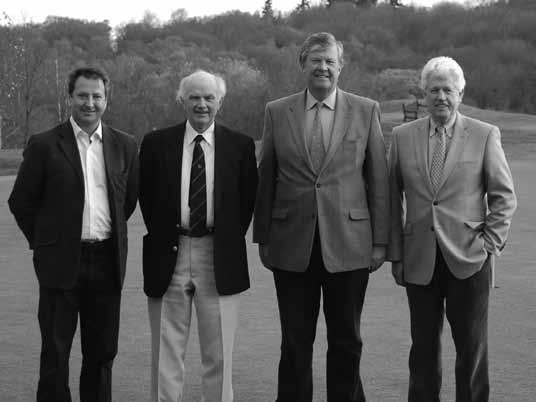
otherwise be unfunded. In time a broader regime of giving will be developed.
It has been decided, amongst other things, to use some of the money to equip each new young person starting the pre-apprentice course with a tool box; to fund precious metals for them to work with; and to develop a Knowledge Transfer Partnership in collaboration with a suitable university to support the development of a young postgraduate material scientist. In addition to developing this scientist’s relevant skills, which can be drawn upon in future for the benefit of the trade, it will also provide sustainable high-level support and resources from the university. Without such a programme this area of expertise will in time no longer be available. The Company has recently decided that, in future, selection to the Livery will be by application. This is a significant change to the current procedure, and the Committee is now working on the criteria for applicants and pondering the considerable administrative details to enable this to be done. Once decided, a calling notice will go out to all eligible freemen. With eleven committees in operation, there is a recurring need to find people to serve on them, and so volunteers are regularly being sought. If there is a committee which appeals to you then please apply through the Members’ Website and while you are there do please make sure that your other details are up to date.
And finally, every year I am looking for members who can represent the Company at a variety of sporting events, such as: golf, sailing, tennis, shooting, and skiing. The Wardens normally support the entrance fee for such competitions with a modest individual contribution. If any of these activities interest you then please make contact with me.
An impressive sum of £59,000 has been raised, including Gift Aid and the wardens’ matched funding
Two topics have dominated the deliberations of the Membership Committee this year: the new Members’ Charitable Fund (MCF) and the issue of selection for the Livery. The idea behind the MCF is that the variety and considerable extent of the Company’s charitable giving is only possible because of the generosity of previous generations. It was thought that this fund would be a good way of connecting members of the Company with the principles and values which have contributed to making the Company what it is today. The Prime Warden wrote to all members explain the nature of the programme and that this is voluntary, reflecting the different circumstances of individual members. To provide some incentive to members, the Wardens agreed to match fund contributions at the rate of £1 for every £5 donated up to a maximum of £10,000 in the first year. The Company would like to thank all those who have donated to the MCF to date, particularly those who did so by standing order. An impressive sum of £59,000 has been raised, including Gift Aid and the Wardens’ matched funding. The Membership Committee has recommended that this should be used in the first instance to support elements of the Trade and, particularly in this first year, those projects within the Goldsmiths’ Centre which would
By Dr Robert Organ
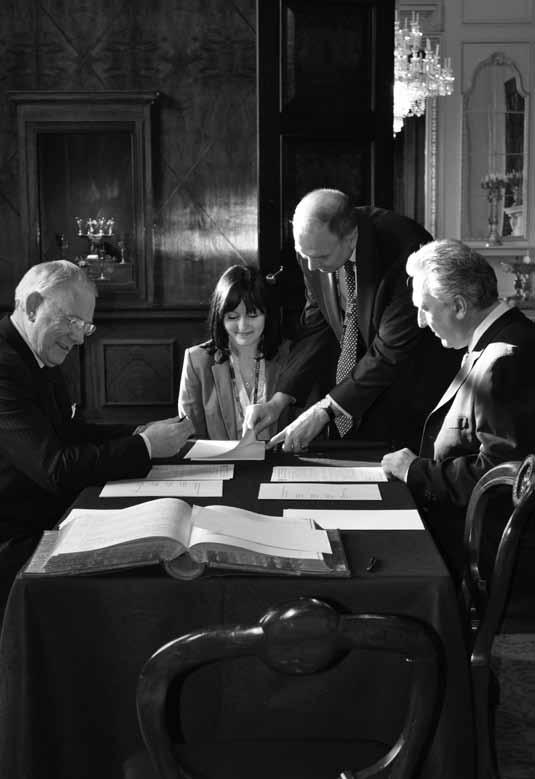
The decline in articles sent for hallmarking continued into 2011. For all UK offices, the total number of articles hallmarked fell from 14,926,518 in 2010 to 10,861,906 in 2011, a drop of 27.2%. Gold input fell by 24.5%, while silver fell by 29.6%. London fared slightly better than the other UK offices, with the total number of articles hallmarked falling from 2,887,892 in 2010 to 2,444,835 in 2011, a drop of 15.3%. The relatively better performance, albeit in a falling market, pushed market share up to a peak of 27% in some months, the highest level for a decade. The financial impact of the downturn in article throughput was, however, tempered with generation of additional income from assaying and smelting services required by
companies who buy scrap gold. Diversification into such related activities will be a key activity in 2012.
The two sub-offices continued to go from strength to strength. The Heathrow Sub-Office hallmarked 905,533 articles in 2011. For two months during the year, it became the largest of the three operating sites in terms of articles hallmarked. At Greville Street, 145,434 articles were hallmarked and in December it celebrated its fifth year of operation. Champagne, specially designed cup-cakes, and a rare appearance of Andy Waker on the public side of the counter to greet people marked the occasion. Investment in technology continued in 2011 with the purchase of a state-of-the-art laser for making punches. This new laser has allowed the Assay Office Engineering Workshop to produce the most detailed 0.3 mm panel height punches available on the market today. A new MS text messaging service indicating that hallmarking packets were ready for collection was introduced in 2011 and this has proved popular with customers.
The Assay Office continued to organise a range of events including Fakes and Forgeries Seminars, Hallmarking Information Days and Training Days for Trading Standards Authorities. It participated in the NAG Annual Valuation Conference, the Trading Standards Institute Annual Conference, International Jewellery London and many other smaller events. The launch of the Diamond Jubilee Mark took place at Goldsmiths’ Hall, attended by HRH Princess Michael of Kent. It is hoped that this mark, and activity generated by the Olympic Games, will give a much needed boost to the trade in 2012.
Major triennial audits of the Assay Office were carried out by UKAS and ISOQAR with the result that the Assay Office retained its accreditation to international standard ISO 17025:2005 and its certification to ISO 9001:2008.

A total of 69 pieces were examined by the Company funded Antique Plate Committee, of which 17 conformed to the Hallmarking Act. The remainder comprised 15 with alterations and additions, 7 with transposed marks, 14 with counterfeit marks, all of which were within the Committee’s jurisdiction.
A total of 14 suspected offences against the Hallmarking Act were reported to the Office by Local Authority Trading Standards Officers, which resulted in one prosecution.
Standards Committees
The Assay Office hosted a meeting of Technical Committee TC 174 at Goldsmiths’ Hall where further work was carried out to update the many ISO standards relating to the testing of precious metal jewellery.
International Convention on Hallmarks and International Association of Assay Offices
The Hallmarking Convention technical annexes were modified so that a separate fineness mark could be omitted if its application was likely to cause damage or there was insufficient room for its application. The Common Control Mark must still be applied. Other changes were made to allow smaller Common Control Marks to be applied. Italy is aiming to accede to the Hallmarking Convention in 2012 and India, which already operates over 60 assay offices, also stated its intention to join.
Over the last 12 months, no new Assay Offices signed the Memorandum of Understanding for The International Association of Assay Offices (IAAO).
Changes to the Hallmarking Act
Current hallmarking legislative arrangements were drawn into a review as part under the Government ‘Red Tape Challenge’. The review was conducted by inviting responses through a Government website. Retention of the current legislation received an overwhelmingly positive response, especially from the major trade organisations. The Government respected the high esteem in which hallmarking was held and confirmed that no changes would be made.
It is expected that the Legislative Reform Order (LRO) to permit off-shore hallmarking by UK Assay Offices will be completed in the first half of 2012.
Staff
Robert Grant, Robert Hinson and Yvonne Trotman received their freedom.
David Merry completed 40 years of service. His enthusiasm and commitment is as strong now as ever, providing considerable inspiration for younger members of staff. It was
entirely appropriate that he should become the Master for a new apprentice, Candice Devine, who follows Robert Grant and Robert Hinson who both successfully completed their apprenticeships in the summer. David’s influence unfortunately did not extend to Robert Grant’s choice of ‘hoodie’ which remains a constant source of mirth and (deserved) derision.
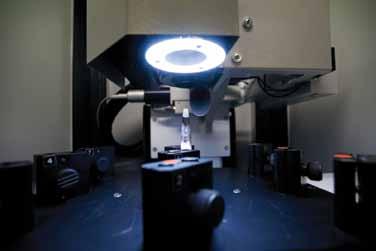

By Nick Harland
This has been a year of developing some new initiatives in the education field, within the Education Committee’s overall budget of £320,000.
Our ‘From the Field’ programme with the Royal Geographical Society is bedding in, and the first full year of Goldsmiths’ bursaries has just been completed.
The five teachers, who each received £1000, linked up with expeditions examining issues ranging from ocean acidification to glacial landscapes. This is proving productive and popular – with each teacher using their link with researchers to develop lesson plans for other teachers to use in support of the curriculum – and the scheme contributes to teachers’ Continuous Professional Development.
The Science for Society programme for secondary school science teachers expanded its reach last year with the inaugural Sustainable Energy course at Bath University, which proved a considerable success. Teachers have been enthused by practical sessions involving the making of plastics (currently oil intensive) and photovoltaic cells, which can be replicated back in the classroom. Other subjects covered included developing hydrogen as a fuel and anaerobic digesters. This year the course will expand to cover producing biofuels from algae and visits to a wind farm and a fuel cell manufacturer. In all the Company is devoting £65,000 to these five courses. The Goldsmiths’ model has been taken up by the Ordnance Survey which has devised its own course, on the theme of physical geography, with Southampton University and so, this year, geography teachers will be added to the Gala Dinner mix of teachers. Our engagement with Engineering UK has seen the development of a new initiative in materials science as part of their ‘Tomorrow’s Engineers’ programme. The grant of £10,000 will support school pupils in ten schools at the Key Stage 2-3 transition level in meeting the challenge of designing and building something using modern materials as well as promoting an awareness of engineering career options. The programme will be a collaboration with the Institute of Materials, Minerals and Mining. Meanwhile, support for the British Science Association (BSA) resulted in the Company’s sponsorship of the Chemistry Prize for school children of all ages in the national competition which was awarded by the Prime Warden at this year’s Big Bang Fair in Birmingham.

The six primary schools which receive funding for literacy and numeracy are all thriving and last year were offered some additional support for buying library books. The Committee has decided to start the search for another school to adopt before the start of the 2012 academic year. This year, the National Theatre’s Primary Classics play, entitled The Island and awarded a grant of £5,000, was aimed at playwriting in the curriculum and was a terrific production which provided much food for thought for teachers and children alike. Two of the Company’s primary schools participated. The Company
the Goldsmiths’ model has been taken up by the ordnance survey which has devised its own course
continues to support this worthy cause with a grant of £5,000. Likewise, our Primary Schools have been introduced to the BSA’s ‘Creativity in Science and Technology’ programme.
The ‘Grants for Teachers’ awards have continued to attract some innovative and enthusiastically promoted projects. Grants were given this year to ten teachers for up to £5,000 each. Topics for exploration include: how to engage Afro-Caribbean boys at secondary level; the use of dogs in teaching children with behavioural issues and disabilities; and ‘The English Kingdom and its Fall 1421-1453’.
All in all, the diverse range of educational engagement is a source of considerable satisfaction, and it is particularly rewarding to see how much the Company’s efforts in this field are appreciated.
By Harriet Taylor
In 2011 – 2012 the Charity budget remained at the previous level of £800,000. Over this period very few grants were made of £5,000 – the Charity Committee preferring to help more charities at the £3,000 level. Multiple year grants are now rarely given to allow the Company to offer the widest possible help. The combination of a reduced budget, alongside an increase in the number of appeals being received as charities struggle in the current financial climate, led to some tough decisions in the Charity Committee meetings. The current appeal success rate stands at 54.7%, in comparison with 69.7% in 2009-2010; this tells its own story.
During the year, the Deputy Clerk and the Charity Administrator made visits to see the work of the Sussex and Northamptonshire Community Foundations accompanied by other members of the Committee. Following these visits and the receipt of their respective reports, both were awarded the final instalment of £50,000. The Committee is currently reviewing its support of Community Foundations, with the likelihood that only one Community Foundation will be supported in 2012-2013. In addition to Northamptonshire and Sussex, an exceptional grant was made to the London Community Foundation to underwrite the launch of their ‘Surviving Winter Appeal’. Through this those who could afford to were invited to donate their Winter Fuel Payment to the Community Foundation to distribute to older people in greater need. This appeal is going well, with £56,727 being received by mid April this year.
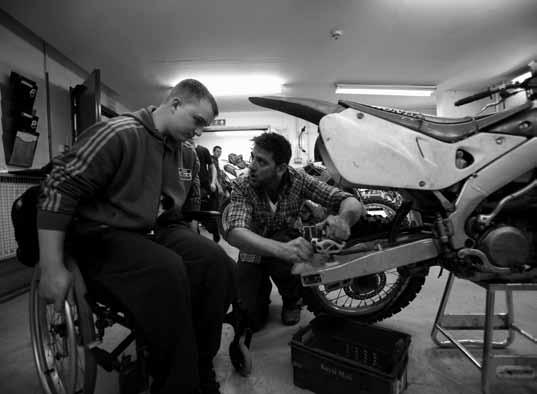
In July 2011 Lambeth Borough Council received its final instalment of £25,000 under the ‘Poor Londoners’ programme. The Committee made the decision not to select a further Borough for the time being, preferring to award additional grants to the RL Glasspool Charitable Trust and SHS (School-Home Support), thus enabling the funds to reach those individuals most in need throughout London.
Inundated with appeals from individual churches and hospices, the Charity Committee took the decision in 2008 to select umbrella organisations to distribute funds in these areas. The Company now makes block grants of £50,000 to the National Churches Trust and of £10,000 to Together for Short Lives (formerly Children’s Hospices UK). This arrangement is reviewed every year but, for the time being, appears to be a good solution to the large number of appeals previously being received.
While most grants were around the £3,000 mark, the Company’s long standing relationship with the Refugee Council continued with a grant of £10,000 towards its core funding. Grants of £5,000 were awarded to a handful of charities over the year including the Foundation for Young Musicians, MERU (Medical Engineering Resource Unit), Kingston Churches Action on Homelessness, the Archway Project and the Mobility Trust.
Additional charitable grants made by the Wardens included £25,000 to Goldsmiths’ College, £10,000 to the Bishopsland Educational Trust, £5,000 to the National Memorial Arboretum and £5,000 to Bletchley Park. The Wardens once again also agreed a number of back to back grants to enable charities to use the Hall for fundraising events.
An exceptional grant was made to the london Community Foundation to underwrite the launch of their ‘surviving winter Appeal’
it is gratifying that so much of what the department does is helping to influence wider government strategy
By Paul Dyson
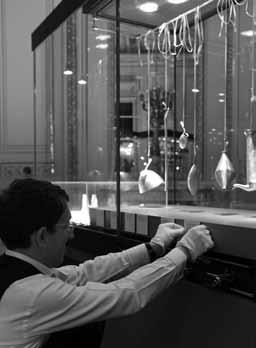
It has been another busy year in difficult times for craftsmen. Despite the high level of precious metal prices, well-designed and high quality jewellery and silver continue to sell well. However, with each further year of my experience within the Company, it becomes more apparent that the promotion and marketing of this sector’s work is an essential part of the Company’s activities. A report in January confirmed this but left the Promotions Committee with a harsh reality – to spend the available money on marketing or on exhibitions?
Last year our summer exhibition Mindful of Silver (27 May–17 July), allowed 12 silversmiths to create ‘a vessel’ and to show how their very differing design processes produced radically distinctive results. The exhibition, conceived by the Prime Warden, Hector Miller, was curated by Julie Chamberlain who invited Vladimir Böhm, David Clarke, Rebecca de Quin, Sarah Denny, Grant McCaig, Alistair McCallum, Peter Musson, Theresa Nguyen, Michael Rowe, Toby Russell and Lucian Taylor to exhibit. Paul Waller produced a simple and stylish concept design. Although the numbers of visitors was less than expected those who did visit were rewarded by the individual displays which invited them, the viewer, to consider, and to appreciate, how an idea was developed from thought, through different processes, to a 3D object. The Company is most grateful to Cookson Gold which loaned bullion to the craftsmen to enable them to produce larger objects.
For London Jewellery Week (6-10 July) there was a week of events, including Days of Knowledge at the Hall and The Goldsmiths’ Pavilion at Treasure, resulting in press exposure in the Evening Standard and Country and Town House. The Goldsmiths’ Pavilion generated over £200,000 in orders over three and a half days for the 44 craftsmen involved. This year, (13-17 June), 80 jewellers, including a large number selected from the website, Whoswhoingoldandsilver , have been signed up to participate in the prestigious venue of Somerset House on the Strand.
The 2011 Goldsmiths’ Fair, by maintaining its high standards of craftsmanship for both jewellery and silver, continued to enjoy increased sales despite a lower footfall. The Company was delighted that both the Duchess of Gloucester and Princess Michael of Kent found the time to attend this event. Arrangements are in hand for the 30th Fair (24 September – 7 October 2012).
The website, Whoswhoingoldandsilver , is continuing to expand under the careful editorship of Tom Bowtell. There are 325 subscribers now, an increase of around 10% in the last year. Tom is following his great passion – the theatre –and left in April. The Department owes him a great debt for his unobtrusive and very considerate skills in managing this new website for the past six years,
The highlight of the 2012 calendar is, without a doubt, Gold: Power and Allure. This major exhibition has benefited from a generous financial contribution from the World Gold Council, which is celebrating its own 25th year. Gather a group of friends together for a visit to what promises to be a chance of a lifetime exhibition covering 4,500 years of Britain and its association with gold.
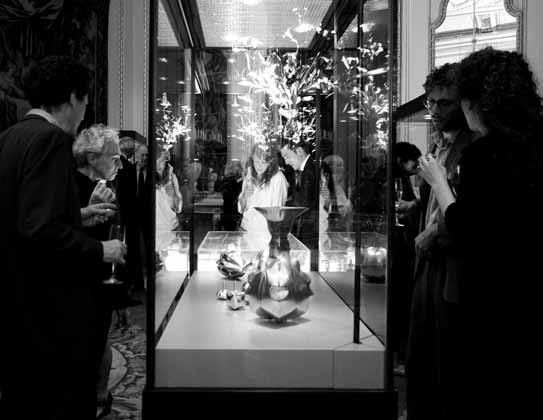
the Goldsmiths’ Pavilion generated over £200,0 00 in orders over three and a half days for the 44 craftsmen involved
By Peter Taylor
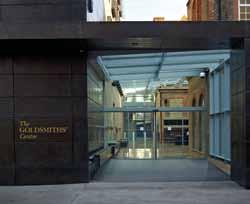
This year is best summed up as a period of change for the Department as it geared up for the opening of the Goldsmiths’ Centre, which should have taken place in October.
As usual the GettingStarted Course kicked off the year with a celebration of the thirtieth anniversary of the programme which has launched many notable careers within the craft and industry. A bumper programme of guest speakers combined to produce a successful and memorable course for all the participants. The evening reception was attended by many past participants who shared their experiences with this year’s cohort.
The Company’s apprentices then did very well at the annual Goldsmiths’ Craft and Design Council Awards scooping a number of top prizes including the Paul Podolsky Award. It is a source of enormous pride for the Company that the young men and women on the scheme continue to demonstrate the highest levels of craft skill; a fact that was reinforced by the involvement of Robyn Allen at the 2011 World Skills Competition which took place at Excel, Docklands in October. A member of Team GB, Robyn represented her country in the Fine Diamond Mounting competition and, whilst un-placed, brought enormous credit to the trade with her dedication and commitment to the competition. Finally with regard to the Apprentice scheme I can report that it was reviewed by City & Guilds in December and the ‘Delegated Authority’ to make our own awards was renewed and a further five candidates for the Goldsmiths’ Award approved.
The future of such qualifications for the sector was high on the agenda as the Department worked with the Creative & Cultural Sector Skills Council to agree a new suite of qualifications at Level 2 and Level 3 which would mean that Government Apprenticeships could be made available to the industry across the UK. It is gratifying that so much of what the Department does is helping to influence wider government strategy and this work will be built on as the Goldsmiths’ Centre moves forward.
The Technical Journal has become an important part of the
materials produced by Department along with the training DVDs. Last year, the seventh in our Masterclass series of DVDs was produced. Christopher Lawrence demonstrated the art of sinking a tray from flat silver sheet, a time-consuming and highly skilled process. There was a short interregnum in both areas whilst the Goldsmiths’ Centre went live but both activities will continue under the management of the Centre from 2012. In summing up the past 12 months I must thank some of the people that made these activities possible within the Department but who have now departed.
Rebecca van Rooijen is developing Benchpeg, the online community that she created and which has grown to amazing proportions. Rebecca’s hard work and dedication was instrumental in laying the foundations for the Goldsmiths’ Centre. Karin Paynter also made the decision to leave to pursue other areas of interest. Her leadership in developing and delivering the core Technology & Training Programmes at the heart of the Department’s activity also needs to be recognised. Without her contribution the Goldsmiths’ Centre would have been a far more difficult project to deliver. Both she and Rebecca were made Freemen in March 2012 in recognition of their achievements.
Finally Heather Ferguson, the longest serving member of the team, retired after many years of dedicated service to the Company and to the Department. For many Heather was the Department – with her knowledge of the craft and industry and her experience gained over her time with the Company, she is much missed.
However, looking to the future, the Goldsmiths’ Centre opened in February 2012. The activities which have been at the heart of the Technology & Training Department will continue albeit that they will be delivered by this new entity on the Company’s behalf. A new Committee to support the work of the Centre and ensure that it delivers against its potential has been formed under the Chairmanship of Grant Macdonald. The Goldsmiths’ Craft & Industry Committee will provide continuity and will ensure that all the hard work that the Technology & Training Department has done over the last few years will be built on; as always the Department is most grateful to all those who have enabled this to happen.

these candelabra are a fitting tribute to celebrate Grant macdonald’s year as Prime warden from 2008-09
By Rosemary Ransome Wallis
In 2011, the National Trust property, Kedleston, the classical masterpiece in Derbyshire designed by Robert Adam and built for Nathaniel Curzon in 1765, hosted the StudioSilverToday exhibition featuring the young artist craftsman Theresa Nguyen as silversmith-in-residence. The second exhibition in a series of five which I have initiated with the National Trust, it brought contemporary silver to a vast new audience. 120,000 visitors were recorded viewing the exhibition in the March – October season, with Kedleston becoming one of the top 16 National Trust properties to visit in 2011 as a result of this exhibition.
This year’s StudioSilverToday exhibition is at Ickworth in Suffolk, featuring the talented young Miriam Hanid as silversmithin-residence. Also the supporting lecture programme there will include renowned artist craftsmen, Charlotte De Syllas, Ros Conway and Rod Kelly who are based in East Anglia, speaking about their major contribution to this exceptional decorative art.
An evening of lectures was a highlight of the Corieltavi Silver Bowl: 2000 Years Old exhibition, held at the Hall from May –July 2011. Given by myself, Frank Hargrave, then Keeper of Market Harborough Museum, and the silversmith, Alex Brogden, the lectures told the extraordinary story of the discovery of the Hallaton Hoard, valuable Iron Age material belonging to an open air shrine found on a hilltop in Leicestershire. In 2010, I established, with Assay Office expertise and Alex Brodgen’s silversmithing skills (he made a replica of a silver bowl found in the hoard), that the original ancient silver bowl found in the hoard was unique. Made 2,000 years ago by an indigenous Iron Age silversmith of the Celtic Corieltavi tribe, this enigmatic bowl is the earliest example of such silver extant today and provides new evidence of a previously unrecognised silversmithing tradition in this country. The exhibition featured both the original and replica silver bowls set against
the background of the site’s history and other related material found there. It caused great interest in the archaeological world as well as fascination and connection from those in the trade who viewed it.
The creative skills of silversmithing are encouraged each year with the Young Designer Silversmith Award competition.
In 2011, Shaun Grace, a student from University of Creative Arts at Rochester, won it with his complementing silver vases. Made in the host workshop of Steven Ottewill, these innovative pieces were presented on 21 October to the new Director of the Victoria & Albert Museum, Dr Martin Roth, for the collection there. Shaun is to exhibit work this year in the Contemporary Silver Gallery exhibition at the Goldsmiths’ Centre directed by the enthusiastic John Higgins. This is his personal gallery, which hosts a selling exhibition each year and from which, last year, the Company purchased an unusual tumbler cup with a creased lip by Malcolm Appleby. Amongst other purchases in 2011 the Company acquired Angela Cork’s Tilt dish and Quadrangle dish. These scored and folded presentation containers for dessert fruits extend one’s perception of such containers. However through their tilted angles, they become, when empty, sculptural forms in space.
Dual function underpins the work Embrace by Anna Lorenz which the Company purchased from her Goldsmiths’ Fair stand. The work consists of a sterling silver mesh hemisphere and an oxidised mesh hemisphere on a Welsh slate plinth. It can function as two separate vessels, to hold fruit for example, or be combined as one vessel to form a stylish table centrepiece. Stylish too is the Indulgence platter purchased from Mary Ann Simmons as well as the technical tour-deforce hammered beaker by William Lee. Like William who won the YDSA competition in 2003, Theresa Nguyen was the winner in 2005. This competition identifies a rising star silversmith. Certainly, this was the case for Theresa in 2011. Her Spiritus centrepiece, inspired by the energy of plants growing, shows her technical skill to produce in Britannia silver by fold forming and hammering a really eye-catching piece. It featured on the 2011 Mindful of Silver exhibition poster and was subsequently bought by the Company for the Collection.

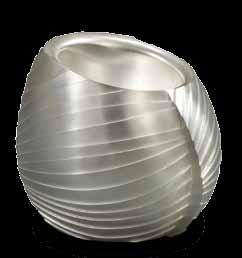
The 500 year old Japanese tradition of shibuichi and shakudo alloys to achieve different colour patinas remained virtually unknown in this country until researched by Dr Coilin O’Dubhghaill at Sheffield Hallam University. These patinas, resembling lacquer in appearance, were historically used in Japan to decorate katana sword fittings worn by the Samurai class of feudal Japan. The Company purchased two contemporary bowls from Coilin showing his innovative interpretation of these ancient techniques.
Developing modern techniques is the mission of Kevin Grey. The Company commissioned a bowl developing his laser and TIG welding skills in the ribbed decoration that he used. The result gained him a Goldsmiths’ Company Award plus a Gold Award for the London Assay Office Special Award for Technical Innovation in 3D in the 2012 Goldsmiths’ Craft and Design Council Competition.
A skilful use of 3D computer modelling software producing models for rapid prototyping is evident in the jewellery design of Jo Hayes-Ward. The Company commissioned her in 2011 to extend her aluminium Random Master brooch to incorporate gold cubes. She produced a brooch that is a masterpiece of design and technical craftsmanship, particularly in creating exceptional light refraction in a brooch form.
Light catches the rich colours of Sheila McDonald’s cloisonné enamel bird brooch which the Company purchased from her at the 2011 Goldsmiths’ Fair. It now joins the repertoire of wonderful jewels that the Company not only exhibits but also lends to the wives of Court members to wear at formal dinners at the Hall. At these magnificent occasions, the tables in the Livery Hall are decorated with silver candelabra, both antique and modern. The Company is delighted that Grant Macdonald was commissioned in 2011 to make a pair of contemporary two-light candelabra in the form of graceful opposite ‘C’ scrolls. The challenge of hammering sheet in opposite curves, annealing the silver, wired onto a tool to keep the shape, before soldering the two halves together is silversmithing at its best. Thus these candelabra are a fitting tribute to celebrate Grant Macdonald’s year as Prime Warden from 2008-09. His commemorative portrait medal by Jane McAdam Freud is equally contemporary, and shows Jane’s skill as an art medallist, choosing a new form of medal portraiture, a miniature portrait bust sculpture. In doing this, she has added a new dimension to the Company’s renowned art medal collection. As have the other pieces acquired by the Company for its Collection in 2011.
By Eleni Bide
This report begins with some sad news. Susan Hare, the former Librarian, passed away on 20 February 2012. She began working for the Company in 1958, serving for 31 years, and shaped the Library in its modern form through her expertise and enthusiasm for silver and jewellery. The success of this library rests on the very substantial foundations which she established.
This year the Library has made some exciting acquisitions. New books included a strong selection of works on jewellery, from those with a contemporary focus, such as the catalogue Tinker tailor soldier sailor: 100 women 100 brooches 100 stories, and Joanna Hardy’s Collect Contemporary Jewellery, to the historical perspectives of Diane Venet’s The Artist’s Jeweler and Anna Keay’s The Crown Jewels. The latter is an addition to the Twining special collection on royal jewels and regalia. In other areas new publications came via links with overseas institutions, such as Lisa Funder’s Danish Silver 1600-2000. An important milestone was reached with the receipt of Laurence Worms’ British Map Engravers, a work based on decades of research, including information drawn from the Company’s records.
The archives rarely leave the security of the vault, but this year they have played their part in preparations for the 2012 Olympic and Jubilee festivities. Staff have been busy making
the audio-visual collection has been significantly enhanced with an impressive programme of new photography of the hall’s interiors
arrangements for a number of significant works to go on display in the Guildhall and at Goldsmiths’ Hall this summer. The Library is also responsible for works of art and has safely seen the installation of Richard Collins’ painting The Tea Party at the Geffrye Museum and the 18th century barge coat of arms and figure of St Dunstan at the National Maritime Museum. Ongoing archival research projects include the incorporation of material from Dr David Mitchell’s study of 17th century goldsmiths onto an online database. This will be hosted by the Centre for Metropolitan History, and will make this important scholarship accessible to the public, alongside data supplied by the Mercers’, the Drapers’ and the Clothworkers’ Companies.
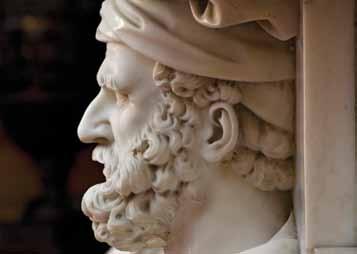
Over the past twelve months the audio-visual collection has been significantly enhanced with an impressive programme of new photography of the Hall’s interiors. Shot by Richard Valencia, the photographs were the first comprehensive visual record of the public rooms taken in over 10 years. They feature in an updated version of the Hall’s guide book, revised by the Librarian and published to coincide with the start of the new Prime Warden’s year in May. The Library itself has welcomed more student visitors, hosting an increased number of educational visits in conjunction with David Merry of the Assay Office.
Finally, changes and acquisitions have also been made on a personal front. In October of 2011 Raakhee Zaman, the Library Secretary for over 15 years, departed to start a new life in Dubai with her husband Khus and three children. She was replaced by Sophia Tobin, who brings with her a wealth of experience from her work at Wartski. Deborah Roberts, a jeweller and gemmologist, took over from Melanie Eddy as Library Assistant in September 2011, but those missing Melanie will be pleased to hear that she has brought her industry expertise back to the Library from mid April, as maternity cover for Eleni Bide, who produced her own acquisition, baby Max on 22 April.
Assay Office
Management
Sir Jerry Wiggin (Chairman)
Mr R.D. Agutter
Mr R.G.H. Crofts
Mr C.V.S. Hoare Nairn
Mr G.G. Macdonald
Mr R.E. Southall
Mr N.P. Swan
Mr A.C. Vanderpump
Mr M.R. Winwood
Antique Plate
Mr R.P.T. Came (Chairman)
Mr R.F.H. Vanderpump
Mr N.V. Bassant
Mr A.J. Butcher
Mr P. Cameron
Mr D.E. Cawte
Mr A.J. Dickenson
Mrs K. Jones
Mrs L.M. Morton
Mr A.M. Phillips
Mr H. Willis
Goldsmiths’ Review Board
Mr H.J. Miller
The Lord Sutherland of Houndwood
Mr R.G. Melly
Mr N.J.G. Harland
Mr D.A. Beasley (Editor)
Miss E.R. Bide (Assistant Editor)
House
Sir Jerry Wiggin (Chairman)
Mr R.P.T. Came
Mr M.D. Drury
Mr H.J. Miller
Mrs N. Buchanan-Dunlop
Mr W.N.N. Diggle
The Hon. Joanna Gardner
Mr M.S. Soames
Mr R.W.G. Threlfall
Charity
Mr D.A.E.R. Peake (Chairman)
Mr S.A. Shepherd
The Hon. Mark Bridges
Dr C.G. Mackworth-Young
Mr W.K. Benbow
Mrs S.C. Hamilton
Miss E.K. Himsworth
The Hon. Dr Elisabeth Martin
Mr R.O’Hora
The Rev. Prebendary David Paton
Mr J.R. Polk
Mr W.G. Touche
Education
Mr A.M.J. Galsworthy (Chairman)
Dame Lynne Brindley
Mr W.K. Benbow
Miss C.V. Copeland
Miss H.S.E. Courtauld
Professor J.E. King
Dr V.V. Lawrence
Miss J.A. Lowe
Mr A.C. Peake
Mr R.A. Reddaway
The Hon. Mrs M.C. Sanders
Mr R.G. Straker
The Lady Willoughby de Broke
Collection and Library
Professor R.L. Himsworth (Chairman)
Mr R.F.H. Vanderpump
Sir Jerry Wiggin
Mr T.B. Schroder
Mr C. English
Dr K. Jensen
Mr R.W.G Threlfall
Mr C.H Truman
Mr A.E. Turner
Promotion
Mr T.B. Schroder (Chairman)
Mr M.J. Wainwright
Ms J.L. Clarke
Mrs J.J. Clarke
Mr C. Marsden-Smedley
Mr C. Mellor
Mr N. Semmens
Ms M.A. Simmons
Miss A. Stapleton
Investment
Mr R.N. Hambro (Chairman)
Mr W.H.M. Parente
Sir John Rose
Mr U.D. Barnett
Mr N.A.P. Carson
Mr A.P.A. Drysdale
Mr W. Hill
Sir Stuart Lipton
Mr R.R. Madeley
Craft and Industry
Mr G.G. Macdonald (Chairman)
Mr S.A. Shepherd
Mr R.N. Fox
Mr A.J. Bedford
Mr T.R.B. Fattorini
Mr B.D. Hill
Ms D. Mitchell
Miss J.B. Springer
Membership
Mr T.B. Schroder (Chairman)
Mr M.D. Drury
Mr E.C. Braham
Ms J.L. Clarke
Mr W.T. Edgerley
Mr T.R.B. Fattorini
The Hon. D.M. Harding
Mr G.A. Himsworth
Dame Ros Savill
Miss J.B. Springer
Mr S. Webster Modern
Professor R.L. Himsworth (Chairman)
Mr M.D. Drury
Mr C.E. Burr
Miss V.R. Broackes
Mrs J.A. Game
Miss O.D. Krinos
Mr D. Prideaux
Ms D. Solowiej
Members of the Court of Assistants
Mr H.J. Miller
Prime Warden until 16May2012
The Lord Sutherland of Houndwood, KT, FBA, FRSE
Prime Warden from 16May2012
Mr R.D. Agutter
Mr W.H.M. Parente
Mr T.B. Schroder, FSA Wardenfrom16May2012
Sir Anthony Touche, Bt
Mr C.R.C. Aston, TD
Sir Hugo HuntingtonWhiteley, Bt, DL
Mr S.A. Shepherd
Mr A.M. Stirling
The Lord Tombs of Brailes
Sir Paul Girolami
The Lord Cunliffe
Mr R.F.H. Vanderpump
Mr B.L. Schroder
Mr R.P.T. Came
HRH The Prince of Wales, KG, KT, GCB. (HonoraryAssistant)
Mr D.A.E.R. Peake
Mr B.E. Toye
Mr M.Dru Drury, CBE, FSA
Sir Jerry Wiggin, TD
Professor R.L. Himsworth
Mr G.G. Macdonald
Mr R.N. Hambro
Mr A.M.J. Galsworthy, CVO, CBE, DL
Dame Lynne Brindley, DBE
Sir John Rose
Mr M.J. Wainwright
The Hon Mark Bridges
Brigadier Edward Butler, DSO, MBE
Mr E.C. Braham
Mr R.N. Fox
Dr C.G. Mackworth-Young, MD, FRCP
The Livery
The following deaths of Liverymen were reported during the year (preceded by the year of clothing):
1987
Sir George Blunden 1959
Sir Alan Howard Cottrell
2009
Mr John Frederick Dale 1976
Mr Anthony Philip GrahamDixon
1980
Miss Susan Mary Hare 1966
Mr Stewart Reginald Vyvyan Pixley
The following Freemen were elected to the Livery and duly clothed during the year.
Mr Alderman Jeffrey Richard de Corban Evans
Mr Stamford Timothy John Galsworthy
New Freemen May 2011 to May 2012
By special grant
Stamford Timothy John Galsworthy CompanyDirector
Karin Kernick Paynter
Designer
Seif Salim
Accounts Assistant, The Goldsmiths’Company
Amanda Stücklin Press Officer, The Goldsmiths’Company
Yvonne Phyllis Trotman
Receptionist, The Goldsmiths’CompanyAssay Office
Rebecca Wilhelmina Gabriella van Rooijen
Jewellery Professional
By redemption
Alverne Robert Bolitho
Investment Management
Nicola Christa Byrom PhD Student
Angela Margaret Cork Silversmith
Henry John Deakin Director, Deakin & Francis Ltd
Jeffrey Richard de Corban Evans
Alderman
Kirk Sealy Gregory Diamond Mounter
David John Gwyther
Secretary,British HallmarkingCouncil
Gordon Daniel Hamme CompanyDirector
Philip John Horton Goldsmith
Paul Richard Jones
Goldsmith
Anton Johannes Kata Jeweller
Harriet Alice Kelsall
Jewellery designer
Amanda Jane Mansell
Jewellery designer maker
Rodney Stuart Melville
Chartered Architect
Miles Robert Carmichael
Mitchell
CharityOperationsDirector
Alastair Michael Moss
Solicitor
Robert Duncan Muir
CorporateAnalyst,Finance
Joanna Frances Newman
Education development
Rodin Darcy Tristram
O’Hagan
QualityManager,Alfred Dunhill Ltd
Julian Humphrey Prideaux CharteredSurveyor
Alexandra Beatrice Ramsay Silversmith
John Michael Skliros TD
Graphicdesigner,Territorial ArmyOfficer
Peter Robert Denis Elsworth
Steen
Solicitor
George Montague Derek Styles
Retailer
Lucian Benjamin Taylor
Silversmith
Jonathan Anthony Wainwright
Retailer
Kevin Eric Williams Silversmith
By Patrimony
David James Loyd sonofDominicGeorgeLewis Loyd, a Freeman
Emma Claire Macey daughterofJohnCharrington, a Freeman
By service
Robert Paul Richard Grant son of Dawn Grant and late apprentice of David Ian Merry (TheGoldsmiths’Company AssayOffice)
Robert James Hinson sonofDavidGeorgeHinson and late apprentice of David IanMerry(TheGoldsmiths’ CompanyAssayOffice)
Phillip Matthew Wilkins sonofStephenJohnWilkins and late apprentice of Alister Theodore Fennell
Associate Member
The following have been enrolled as an Associate of the Goldsmiths’ Company honoris causa: Mrs Vivienne Becker
Binney Medal Winners
South Yorkshire Police awarded a joint Binney Medal to Mr Paddy Douglas and Mr Alastair Parr from Northern Ireland.
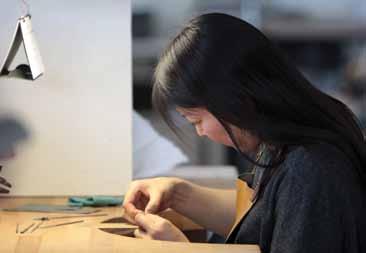
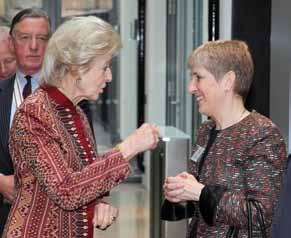
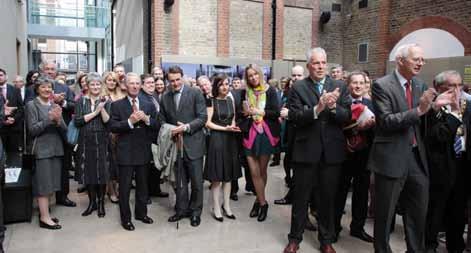



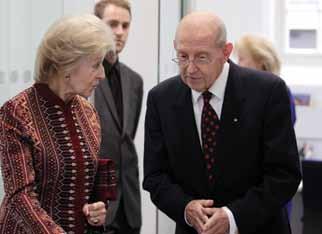
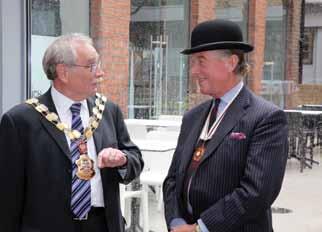
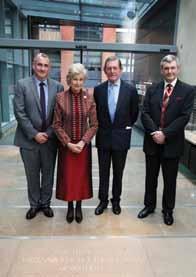
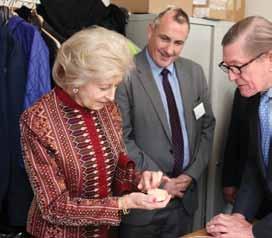
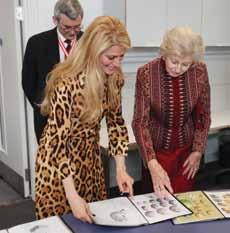

May 2010/2011
Silver Today at Kedleston Hall
The exhibition, from 5 March29 October 2011 at Kedleston Hall, attracted 120, 000 visitors. The prize draw for the beaker designed by silversmith in residence Theresa Nguyen was won by Mrs Sheila Lake, who was randomly selected from 9,500 entries.
Curated by Julie Chamberlain, this exhibition included work by Vladimir Böhm, David Clarke, Rebecca de Quin, Sarah Denny, Grant McCaig, Alistair McCallum, Hector Miller, Peter Musson, Theresa Nguyen, Michael Rowe, Toby Russell and Lucian Taylor. It ran from 27 May to 16 July 2011.
At New Designers (19 June2 July) Fiona Bryony Jackson (Buckinghamshire New University) and Filipa Oliveira (Duncan of Jordanstone College of Art) were presented with prizes for silversmithing and jewellery respectively. This year the Company also awarded grants to 21 colleges exhibiting at New Designers.
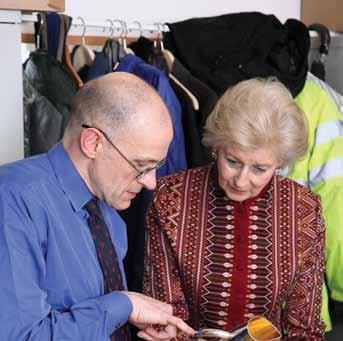
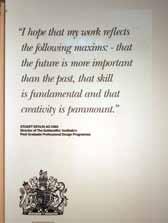
Princess Michael of Kent attended the launch of the Diamond Jubilee mark on the evening of 5 July 2011. The event was hosted by the Company, and included representatives of all four UK assay offices.
Twenty second year students attended the Summer School, which ran from 25 to 29 July. The course was led by Stuart Devlin and Peter Taylor. Goldsmiths’ Fair 2011
The Fair ran for two weeks between 26 September and 9 October and attracted 9,809 visitors. Despite a slight decrease on visitors from the previous year, sales, commissions and future orders increased to £3,451,258.
Young Designer Silversmith Award 2011
Shaun Grace’s flower vases were presented to the V&A for its permanent collection on 25 October 2011. Brian Hill, past Course Leader at the University for the Creative Arts at Rochester, received the commemorative silver plaque, designed and
made by Keith Redfern and engraved by Stanley Reece, which is awarded to the winner’s college.
The programme ran between 23 - 27 January and was attended by 40 delegates.
An evening reception was held on 26 January.
Young Designer Silversmith Award 2012
Judging took place on 31 January, when Kate Earlam of Bishopsland was selected as the winner.
The second prize was awarded to Katherine Duncan, a third year student at Glasgow School of Art.
Trial of the Pyx
The Trial of the Pyx took place on 7 February 2012, and included 3,600 New Zealand coins amongst almost 82,000 coins. Belinda Brown, the New Zealand Deputy High Commissioner, was in attendance to see the counting undertaken by 17 jurymen summoned by Master Lawrence, the Queen’s Remembrancer.
The Delivery of the Verdicts was on 4 May.
Studio Silver Today at Ickworth House
The National Trust’s Ickworth House is hosting this exhibition and artist-in-residence programme featuring Miriam Hanid from 10 March – 3 November 2012.
Goldsmiths’ Centre opened
HRH Princess Alexandra officially opened the Centre on 25 April 2012 when she was guided around the workshops and the Institute by Martin Drury, the Chairman of the Trustees and Peter Taylor, the Director of the Goldsmiths’ Centre. Workshops, starter studios, conference facilities, an exhibition space and a cafeteria form the core services available within this complex.
1 June – 28 July
Summer Exhibition: GoldPowerandAllure(4500yearsof goldtreasuresfromacrossBritain)
29 June
Luncheon Club
24 September – 7 October
Goldsmiths’ Fair
15 October
Open Day tours of the Hall
18 October
Freemen’s evening Reception 23 October Freemen’s evening Reception 12 November
Open Day tours of the Hall
November
Luncheon Club 10 December Open Day tours of the Hall 14 December Luncheon Club
14 January
Open Day tours of the Hall
5 February
Trial of the Pyx: Opening Proceedings
5 March – 8 March
Goldsmiths’ Craft and Design Council: Exhibition
11 March – 13 April
Foyer exhibition: GrowingTalent–jewellersandsilversmiths nurturedbytheGoldsmiths’Company
18 March
Open Day tours of the Hall
22 March
Luncheon Club
22 April
Open Day tours of the Hall
3 May
Trial of the Pyx: Delivery of the Verdicts